Your Bicycle Size Guide

Trek Bike Size Chart By Height In CM & Inches (Road Bike/MTB)
A Trek bike size guide is all you need when the search for the correct bicycle size is still on. Known to be the number 1 performance bike brand all over the globe, Trek has been stacked with powerful engineering and classy bikes.
There are many questions revolving around passionate fans of the brand with one of them being, what size Trek bike do I need?
Well, the answer is very simple. You will need to go through the charts below for a particular bike type and model you are looking for.
Trek size charts
Trek bike sizes can vary, and that can lead to more confusion among potential buyers. The below charts will help in choosing the right model according to your height and inseam.
Trek mountain bike size chart
Trek mountain bikes come in different categories and offer sizes for every individual, starting from extra small to extra large. Take a look at the tables below and select the ideal fit for yourself.
Category – Full suspension, Hardtails, Electric, Cross Country, Trail, Enduro, Downhill, Fat Bikes, and Fuel EXe (E-MTB)
Models/Series – Supercaliber, Top Fuel, X-Caliber, Procaliber, Farley, Roscoe, Marlin, Powerfly, Service, 820, Slash, Remedy, Fuel EX, and Session
Trek MTB Cross Country (820)
Trek e-mountain bike.
Models/Series – Powerfly, E-Caliber, and Rail
Trek road bike size chart
Road bikes are an essential part of the brand that caters to a wide range of audience, thanks to its diverse range of models. These Trek road bike size charts shall help you pick the right bicycle that can go a long way for an adventurous ride.
Category – Performance/Gravel
Models/Series – Madone, Emonda, and Domane
Category – Bikepacking/Cyclocross
Model/Series – 520 and 520 Grando
Models/Series – Checkpoint and Boone 6
Model Series – 1120
Trek electric road bike sizing
Models/Series – FX+, DUAL SPORT+, vEREVE+, and Allant+
Trek alpha sizing for MTB – what is it?
The old-school approach of measuring the frame size of Trek bikes is a thing of the past. With newer inventions and modern bike geometry, alpha sizing is used in place of numeric sizing on Trek mountain bikes.
Why is alpha sizing important?
1. Easier approach
Instead of using size numbers like 19.5, the sizes can be classified into S, M, ML, L, XL, and XXL. So, someone with a 17.5 size can go for the medium and a 19.5 is a large size. You don’t have to keep a tab on numbers; instead, the alphabet makes it easier.
2. Measurement based on reach
In earlier times the frame size measurement of Trek bikes was solely based on seat tube length. Things have changed, and modern mountain bike geometry focuses more on reach as of now. Hence, alpha sizing measures what matters and is a more simplified way of measuring bike size.
Trek sizing – virtual vs actual
This can puzzle you a bit as they both are somewhat similar yet there is a subtle difference. Actual size can be termed as the overall length of the seat tube from the center of the bottom bracket to the center of the top tube intersection with the centerline of the seat tube.
On the other hand, virtual sizing is the overall length of the seat tube ranging from the center of the bottom bracket to the mid-point of the imaginary horizontal top tube in which it connects with the seat tube.
If I had to give you an example, a bike might have a virtual size of 18.5 and an actual size of 17.5. This means that the bike size feels like 18.5, but in actual sense, the frame size is 17.5. It doesn’t make much of a difference as it is there only to let you know what it is (actual size) and what it looks like in size (virtual size).
People also ask
Trek 17.5 frame size – what does it mean.
A 17.5 frame size is considered an M size (Medium) in terms of alpha sizing. Any individual who is 161-172 cm or a height of 5’3.4”-5’7.7” . If you are within this height range, going for a medium size shall be the right choice.
Trek medium frame size is for what height?
A medium size frame size (17.5) is ideal for a person with a height between 5’3.4”-5’7.7 ”. In centimeters, it is ideal for those around 161 to 172 cm in height.
Trek 24-inch bike is for what age?
When it comes to children, their bikes are measured in terms of wheel size instead of the standard frame size. These kid’s bikes have a size range between 12-26 inches, depending upon the height of the kid.
As far as a 24-inch wheel size is concerned, any kid between the ages of 8-11 can go for a fun ride with it. Some of the popular 24-inch bike models are Trek Roscoe 25, Wahoo 24, Trek Precaliber 24 , etc.
Trek 26-inch bike is for what height?
A 26-inch wheel-size bike is for kids with a height of 4’9”-5’3” (146-160 cm) . Wahoo 26 is a prime example of a bike in this category.
Trek 20-inch bike is for what age?
Trek 20-inch bikes are for children between 5 to 8 years of age. Additionally, if they are within the height of 3’9”-4’6” , it should be suitable for them.
Are Trek bikes good?
Trek bikes are considered to be extremely good and solid in build. It is known to be the number 1 performance bike brand all over the globe. Having its humble beginning in the year 1976 in Waterloo, Wisconsin, it has turned into the largest bicycle manufacturer all over the world. With an array of bikes ranging from, mountain, road, electric, and kids bikes, there is a lot to choose from a mammoth list.
How much is a used Trek bike worth?
It depends on a lot of factors in terms of how old the bike is, the year of production, which model, and a lot more. However, it can be within $1000-10,000 (depending on the model and other factors) .
Where are Trek bikes made?
The majority of their bikes are manufactured in Taiwan, China, Netherlands, and Germany too.
Why are Trek bikes so expensive?
Usually, the bike brand prefers top-tier components, suspensions, and frames that are ahead of its competitors. This results in additional costs that can be seen in the price tag and also many top-end Trek bikes are custom-made with less production, leading to being more expensive.
Trek bikes are a class apart in many ways with a range of bikes on offer for its fans across the world. Choosing the right size for you can be tricky, but this is where the Trek frame size chart comes to the rescue.
Trek as a bicycle brand might be on the costly side, but they punch above its weight to provide top-class bikes for the masses. I am always someone who roots for quality, and Trek provides what I need.
One comment
Thanks for your informative post. I really like the Trek alpha sizing for MTB because Trek frame sizes use alpha sizing rather than the usual inches or centimeters (cm), and they usually have a certain range of measurements.
Leave a Reply Cancel reply
Your email address will not be published. Required fields are marked *
Save my name, email, and website in this browser for the next time I comment.


Subscribe to my YouTube channel for video reviews.
Bike Size Chart: How to Choose the Right Bike Size? (GUIDE + Calculator)
This guide will teach you how to choose the right bike size using bike size charts and other methods. It covers the most popular bike types, including hybrids/city, mountain, and road bikes .
Use this interactive calculator that recommends a bike size based on your inseam length and bike type. Alternatively, choose the bike size based on one of the three methods explained below .
Bike Size Calculator
DISCLAIMER: Please remember that the calculator does not consider your height, which may affect your bike size.
What Bike Size Do I Need?
To determine which bike size you need, use one of the following methods, sorted from the simplest to the most complex. Remember that simpler methods are less precise, while more complex methods offer greater accuracy.
Method #1: Bike Size Based on Your Height (The Easiest Method)
This is the easiest and quickest method to select a bike size. All you have to do is compare your height with the general bike sizing chart below .
However, this method doesn’t consider the type of bike, so it may not be as accurate as the methods below. As a result, the bicycle may not fit you perfectly.
Method #2: Bike Size Based on Your Inseam Length and Bike Size Chart
This is probably the best bike sizing method for most people. It is based on measuring your inseam length at home and comparing it with a bike size chart .
Once you measure the inseam length, use it to select the bike size. Most bicycle manufacturers use seat tube length and other details, including the standover height, in their bike size charts.
The standover height is the distance from the ground to the top of the top tube.

If your inseam length is shorter than the standover height, the bike is too big for you.
The clearance, which is the difference between your inseam length and the standover height, should be around 1 to 2 inches.
This clearance is essential to prevent injuries caused by sudden or emergency stops.
IMPORTANT NOTES
- The inseam length for choosing a bike size is measured differently from that used for buying pants. Learn more
- To choose the most accurate bike size, always compare your measurements with the manufacturer’s bike size chart for your bike type.
Hybrid Bike Size Chart
Depending on the manufacturer, hybrid bikes usually come in descriptive sizes (XS-XL) and heights. However, you may still encounter all three types of size designations – in, cm, and descriptive sizes.
And here is a helpful infographic:

Mountain Bike Size Chart
The size of mountain bikes is typically measured in inches (13″, 19″, etc.) or descriptive sizes (XS-XL).
Generally, smaller mountain bikes usually come with 27.5″ wheels, while larger ones have 29″ wheels.
And here are the sizes in the picture:

Road Bike Size Chart
Road bike sizes are usually given in centimeters or descriptive sizes.
You should take extra care when choosing the size of your road bike. Road cycling is a discipline in which you spend long hours in the saddle, so selecting the right bike size is crucial.
It’s also essential to choose the right type of geometry. For instance, endurance geometry road bikes (where you sit more upright) are suitable for beginners, while aggressive (sporty/performance) geometry requires a certain amount of flexibility.
The following road bike size chart also applies to cyclocross and gravel bikes .
And again, an infographic:

Method #3: Calculating the Bike Size
As we know from Method #2 , bike size is determined by the length of the seat tube. To effectively use this method, you must know the length of your inseam ( learn how to measure it correctly ).
To calculate the size of your next bike, use the following formulas depending on the type of bike you want to buy.
To calculate the size of your next bike, use the following formulas depending on the type of bike you want to buy. ( Source )
- Inseam Length (cm) × 0.685 = Hybrid Bike Size (cm)
- Inseam Length (cm) × 0.225 = MTB Bike Size (inches)
- Inseam Length (cm) × 0.665 = Road Bike Size (cm)
1 in = 2.54 cm 1 cm = 0.39 in
After you receive the result, round it up to the nearest whole number. This will match the bike size charts above with a slight deviation.
Example of calculating the MTB Bike Size:
Your inseam length is 33 inches, and you want to buy a new mountain bike. Let’s do the math:
Convert cm to inches: 33 inches × 2.54 = 83.8 cm Calculate the bike size: 83.8 cm × 0.225 = 18.8 ≐ 19 inches
The size of your new mountain bike should be 19 inches .
Example of Calculating the Road Bike Size:
Your inseam length is 70 cm, and you want to buy a new road bike:
70 cm × 0.665 = 46.55 cm ≐ 47 cm
As you can see, your new road bike size should be 47 cm .
How to Measure the Inseam Length?
To measure your inseam length, follow these five simple steps or watch the video below:
- Prepare a 0.75 to 1-inch (1.9-2.5cm) thick book and a tape measure.
- Take off your shoes and stand with your back to the wall.
- Put the book in your inseam, firmly pull it up, and hold it with your tights. Make sure the book is pressed against the wall on one side.
- Measure the length from the top of the book to the floor.
- Take the measurement.
NOTE : The inseam for choosing the right bike size is different (a few inches longer) from the inseam used to choose the pants’ size. Remember that inaccurate inseam length may affect the recommended bike size.

Once you measure your inseam length (and eventually also your height), you can compare it with the bike size chart of the specific bike type. Based on it, you can choose the correct size.
Choosing the correct bike size is easy when you know how to do it. You can use the bike size calculator that recommends a size based on your inseam length and bike type, or try one of the three methods I explain:
- The first method is simple but not very accurate. You only need to know your height and compare it with the universal bike size chart.
- The second method is the most accurate. First, measure your inseam length and decide what bike type you want. Then, compare your inseam length with the hybrid, MTB, or road bike size chart, and you’ll have the right size to buy.
- The third method requires some math but is more accurate than the first. You need to know your inseam length and use special formulas to calculate the size of your next hybrid, mountain, or road bike.
If you’re still unsure about what size bike to choose, please ask in the comments below or email me .
Choosing a Bike Size FAQ
I remember trying to choose the size for my first road bike. I asked a cycling forum for advice because I was stuck between two sizes. The forum members gave me some tips, but most were too complicated for a beginner like me. They suggested that I check the bike’s geometry, but I had no idea how to do that or compare it to my body measurements. So I asked my friend, who has been selling bikes for over 10 years at a local bike shop. He gave me the following advice: “It depends on what kind of rider you are. If you’re a recreational rider, go for a bigger frame. It’s more comfortable because you won’t have to raise the saddle as high as you would with a smaller frame. This will give you a more upright position, which is more comfortable. However, if you’re serious about cycling and want to race, a smaller frame will give you a more aerodynamic and aggressive position. Smaller frames are also more agile and lighter.”
There are several ways to choose the right size bike, but in this guide, I’ll explain three methods: 1. The first method is based on your height and a universal bike size chart. It’s the simplest but not the most accurate method. 2. The second method uses your inseam length and specific bike size charts for hybrid, mountain, and road bikes. It’s the most accurate method for most people. 3. The third method involves calculating the bike size using your inseam length and a unique coefficient that varies based on the bike type. It’s more accurate than the first method but not as accurate as the second. You can also use an interactive calculator that recommends bike size based on your inseam length. I recommend reading the entire article to better understand each method and decide which one works best for you.
Choosing the right bike size is crucial, not only for your comfort but also for preventing health problems. If your bike doesn’t fit you properly, you may experience pain in various body parts, such as your lower back, neck, and hands. ( Source ) According to Physio-pedia.com , there are four essential components of a good bike fit: correct foot position, saddle height, stem length, and handlebar position. However, remember that if your bike is two sizes too small or too big, you won’t be able to achieve a proper bike fit. Therefore, learning how to choose the correct bike size is important. You can avoid discomfort and potential health issues by selecting the right bike size. So, take the time to find the perfect fit for you.
If you have ordered a new bike the wrong size, I recommend returning it as soon as possible. Most online retailers allow returns. If you ride the wrong size bike, you risk injuring yourself (e.g., overloading certain muscles) or not being comfortable in the saddle. It also happens that even experienced cyclists ride the wrong size bike, so they often fail to adjust it to their liking.
It’s a bit complicated. The answer is mostly no, but there are some exceptions. Let me explain. Many people ask this question. But it is a wrongly asked question because bike size doesn’t depend on age. Our heights vary greatly, so a 19-inch bike may suit someone even if they’re not the “correct age” for it. The correct question is: “What height and inseam length is a 19-inch bike for?” With this information and the bike chart for the specific bike, you can determine who the bike is suitable for. Read the entire guide on choosing the right bike size for more information.
A 26-inch bike refers to a bicycle that uses 26-inch wheels. These wheels are commonly found on kids’ bikes, but some adult (mountain) bikes also use them. Nowadays, 27.5-inch and 29-inch mountain bikes are becoming more popular because they offer better comfort and speed. If you’re shorter than 5’0″ (150 cm), a 26-inch bike may be a good choice. However, if you’re taller, I recommend choosing a bike with at least 27.5-inch wheels. Check out this guide to learn more about selecting the right bike size.
Check out my collection of the top online bike stores in the United States and worldwide (Canada, Europe, and Australia) for inspiration.
About The Author
Petr Minarik
6 thoughts on “bike size chart: how to choose the right bike size (guide + calculator)”.
Thanks for the information!!
You are welcome. 🙂
Very informational. Thanks!
I am glad it helped, Richard. ????
Thank you for creating this comprehensive bike size chart! As a beginner cyclist, I found it really helpful in understanding my size and choosing the right bike. I’m looking forward to hitting the trails with my new ride. Great stuff!
Thanks Neil, I am glad you find it heplful. 🙂 – Petr
Leave a Comment Cancel Reply
Your email address will not be published. Required fields are marked *
Save my name, email, and website in this browser for the next time I comment.
Start typing and press enter to search
Road Bike Size Chart: A Simple (But Complete) Guide
“Bike Pursuits is reader-friendly. We may earn a small commission when you buy through our links. Read More!
Many road bikes typically come in 2 styles that include sportive road bikes (that have short top tubes & high front ends for more comfort) and racing road bikes (these are long in their top tubes & low for fast riding at the front). Nowadays, there has been an increase in cyclocross bikes.
These are typically for casual off-road drives. Hence, it has led to the invention of new adventure road bikes. They are drop-bar and lightweight bikes for a mixture of terrains, trails, and roads. For detailed information on the road bikes size chart, keep reading this article.
Road Bike Sizing Guide for men, women & Kids
You need to select an appropriate size of a road bike frame for a new bike that does make all the difference. It is so as when the bike fit is ideal, then you would feel more comfortable while riding. The handling of your road bike would be simpler, and you would enjoy the riding experience more.
In this road bike size guide, we would tell you how simple it’s to look for the right bike size by simply using the following bike size charts (men, women, and kids) for the particular road bike that you are quite interested in.
Road Bike Size Chart for Men
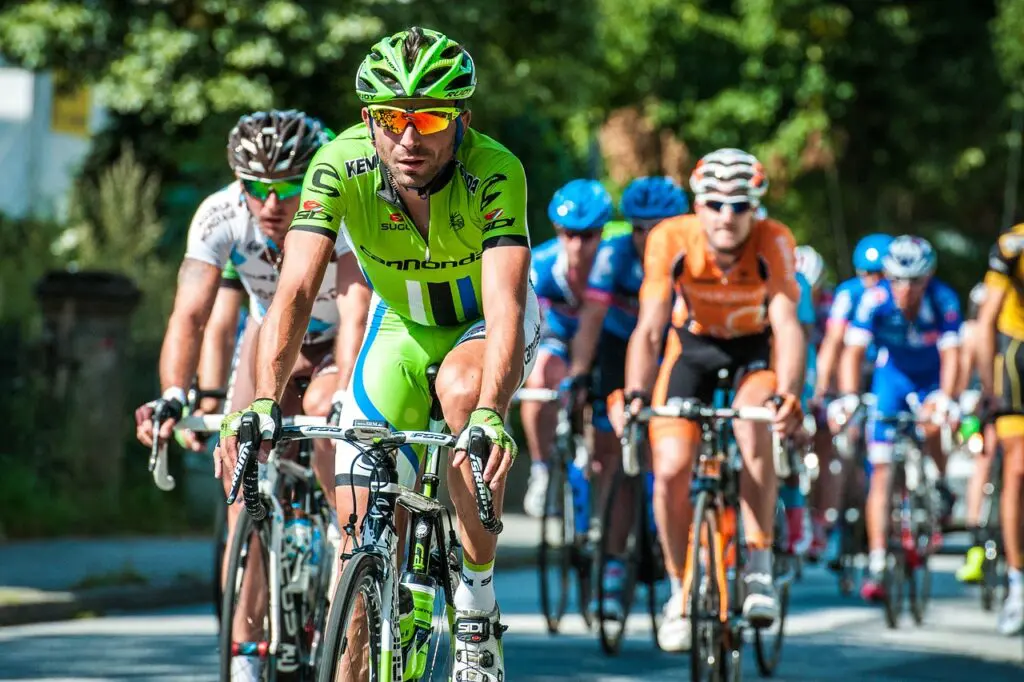
Road Bike Size Chart for Women

Every road bike might look quite similar. However, in case you try out some male’s bike, then you would quickly come to know that it isn’t quite as comfy as you will like. Hence, a good way to purchase a road bike is to see female bike sizes for several types of road bikes.
Surely, this is not a thumb rule, but it provides you a clear notion of what you’ll be looking for. When your road bicycle is delivered, then you might make some necessary adjustments on the handlebars and saddle and all other parts for making sure that you’ll get a perfect ride experience every time.
Road Bike Size Chart for Kids

You can look at following road bike sizing chart for kids to see how kids’ road bikes are defined and measured. You will get a clear idea about what you are actually looking for while shopping for some specific road bike. A crucial thing to keep in mind is that you can measure children’s road bikes by using the tire diameter (outside). It’s just opposite to adult road bikes, whose measurement refers to the bike’s frame size.
One real challenge in picking a child’s road bike is to exactly knowing that the child would outgrow this not long after you buy a bike. Hence, you are facing a serious dilemma. Also, do you purchase a good road bike that would likely be a bit smaller? And, do you buy some big-box clunker that is a temporary and cheap solution? In this case, you are anticipating that a road bike does not fall apart at all or otherwise is such a bad choice which it does turn your child off to riding altogether.
This is a basic question without a simple answer, but probably a couple of other choices that you might explore to assist yourself out. First of all, do you’ve other children, younger or older, that you might give this road bike to them? If this is the case, then it does make the question even simpler about whether or not to consume money on some decent road bicycle.
How about your extended family members, cousins & the like? Also, are there any families in your neighborhood with children that you might set up a kind of road bicycle exchange with?
One more good idea is to resale the road bike. In case you have some connections with the other cycling lovers who have children, they are even more likely to come to know & appreciate the true value of a nice road bike. Offering this for sale, such as you will an adult’s road bike, is a great way to retake some of the investment.
Lastly, certain road bike shops & online retailers (that include Performance Bike) typically offer you some programs for buying children’s road bikes. The main premise is that if you purchase a child’s road bike, you will get either guaranteed trade-in value on your old road bike in case it’s outgrown or some straight out discount offers on the future road bikes. This is quite advantageous because the child continues moving through the road bikes into the large sizes.
What is important to look out for when choosing the right road bike size?
Seeking the proper road bike size is not difficult anymore. All you have to do is simply measure your own height. Now, look at the above road bike sizing chart. You may also want the measurement of your inside leg as different bike brands such as Giant typically use this measurement and height in their particular bike sizing charts.
We have also teamed up along with different professionals to inform you how simple it’s to select the perfect size bike if you are going to buy it online. Also, we offer some useful tips about how to select the best size road bike for yourself when you’re in-between sizes.
Sizes for Different Types of Bikes
The mountain bike sizes and road bike sizes are a bit different. Also, the units that are there in different bike sizes differ, relying on the brand and type. The road bike size charts are generally in centimeters, whilst the mountain bike size charts are available in inches . By luck, our road bike size chart does take away the guesswork because it also tells you road bike frame sizes in inches as well as centimeters. It would be very helpful for you while buying a road bike.
There are a lot of bike manufacturers who typically quote their road bike sizes such as L, M, S, or large, medium or small, etc. on a few or all of their products. Children’s road bike sizes generally depend on the wheel size. Many MTB sizing guides would use inches whilst you may find a road bike size in centimeters. So, it is good for you to know both of them
Sizing in Store
In case you have a road bike just in front of you, just stand straight at the center of the top tube. Also, there must be clearance between the bike and you that is 2 to 4-inches for the mountain bikes & 1 to 2-inches for the road bikes. Are you worried about a seat height sitting properly? Stop worrying. Once you have found the exact size for your road bike from a trial test drive, you might easily adjust your bike to fit properly.
Sizing Online
In case you do not have a road bike just in front of you, then the most crucial measurement for you to know is the inseam. An inseam measure is typically the length from the crotch down to the feet. When you‘ve got this measurement, you can easily use your chart as a buying guide for the best road bike size.
How proper must a road bike fit look like?
As you have selected a right frame bike size; however, that does not mean your road bike fits properly. There is a lot more you should – can – do in order to tune the machine to your body. Why this?
- To go further and faster
- To avoid any type of injury
- For greater pleasure and comfort
The following are the top five techniques to keep your road bicycle setup easy.
1. Adjust the Reach
If you stretch from a bike’s saddle to its bars, it determines the riding position. Plus, your spine must lean at about 45 degrees so you would be able to reach all parts of your bike’s bars conveniently. You should bend your elbows slightly. The excessive stretch is also very common, particularly for females, who usually have relatively short torsos as compared to males.
You might reset the reach along with long or short bars or stems with a totally different reach. Like, for instance, the aluminum OS-99 CSI, ultralight carbon, and aluminum SL-K provide stem along with the +/- 6º rise. It is there in all sizes that are from 70mm up to 140mm, which allows different adjustments. Amongst FSA’s different stems is an SL-K. It contains high-grade aluminum & weighs only141g in a hundred mm length.
2. Adjust the Bar Angle
You can easily neglect the old suggestion regarding drops parallel to the surface – it’d almost surely put so much weight on the hands. You can simply rotate your bars until you get a nice bend in the wrist. Plus, the hoods must not pull the thumbs, such as wishbones.
Your height is a major key. In case you are racing, you will need the bar a bit lower than your saddle. However, otherwise higher or even level is just fine. Its major defining factor is a great level of comfort.
In addition, carbon fiber also damps the vibration for more long-distance performance. On the other hand, a shallow drop, just like a 125mm K-Force Compact, is comfortable as well.
In case you are racing, then you still should not worry about as the 150mm-drop K-Force New Ergo bar offers large-radius curves & a flat, wide top to decrease your fatigue.
3. Adjust the Saddle
As you know, seat height is very much crucial. Your knees must bend a bit at complete extension. You can also adjust via raising your saddle until the leg is completely straight with the heel on your pedal. In case your hips are rocking, then your saddle must be quite high.
Along with the level of pedals, the forward kneecap must sit properly above the road bike’s pedal axle. The laser pointer or plumb bob does assist here a lot. It is not a strict law, though: as you might also reset it to fine-tune your weight on the hands. Pressure must not be very much, but a little.
Lastly, the ‘right’ angle does not put much pressure on the center or front of the pelvis. You need to try to avoid the forward tilt of above some degrees, as it puts a huge weight on the wrists, which is not good at all. You must have a good and durable Seatpost for this. For example, lightweight SL-K posts give you incredibly great adjustments along with the fatigue-decreasing compliance of carbon too.
4. Adjust the Cleats and Pedals
Pressure hot spots typically cut circulation, whilst wrong angles put stress on your legs and knees. These things aren’t good at all for you! If clipped in, balls of your feet must be over your pedal axle, or a tad ahead of the pedal axle. In case you are straining your Achilles tendons or calves, reset your cleat towards your heel. When the arches are sore, then you need to move this towards your toe.
You should look down carefully when pedaling your road bike; the knee must be over the foot. You can easily adjust your cleat side to side; hence the feet are neither inside nor outside your knees. The cleats must mimic the toe-out/in an angle of the feet – and keep this in mind that they may not be similar on each side.
5. Check the Frame
When you are still trying hard to get a well-balanced position, then you might want to think again about the frame size of your road bike after all. The length of the top tube might just be not correct. As a casual guide, we will expect you to see:
- 160centementer-169centemeter (5feet 3inches to 5feet 6inches) bikers on 52- 53centemeter frames
- 171centemeter-181centemeter (5feet 8inches to 5feet 11inches) bikers on 54- 56centemeter frames
- 183centemeter-193centemeter (6feet to 6feet 4inches) bikers on 56-58centemeter frames
Combining the above 5 tips, you must get the maximum road bike fit along with the advantages of cycling longer and faster in better ease, and avoiding any chance of injury.
Invest in a Road Bike Fit
Selecting a professional road bike fit before buying might make a great difference. That is why Missy Erickson, who is a fit specialist and owner at ERO Sports, suggests that the Pre-Purchase Bike Fit for every athlete. “This does not matter when you are purchasing a new road bike from some bike shop, ordering your road bike online, or getting off Craigslist,” she said.
“Knowing about every fit dimension & having a fit expert assist walk one through the whole process and not only makes sure that you’re getting the proper size but your road bicycle also for some specific requirements.”
The road bike fit would also offer all your detailed measurements. Like, for beginner athletes and cyclists, it might be very helpful. Erickson says, “Investing in the bike fit makes sure that you are about to have the right bike. Plus, you will also be going to set up your bike perfectly.
It would ultimately avoid any kind of discomfort, injury, and pain that would make roadside cycling more enjoyable as compared to this already is”.
What if I got my road bike size wrong?
If this happens, you should immediately tell your merchant, who will easily exchange that road bike. In case you do not need to do this, then you might do the following important things:
- purchase a shorter or longer stem. This would change the position of your body
- move the saddle backward or forward
- to get a long seat post
You should give it some time to get the feeling right. As I remember that time when I bought my very first 29er road bike. This felt just like a huge ship & seemed too much tough to ride that in the forest or narrow trails.
However, I have become so much familiar with my bike after some time and could ride with full skill and comfort that while I sit on the 26″ road bike, it does seem so ridiculous how small it’s.
Road Bike Sizing Calculator
The road bikes come with thinner tires as well as light frames. They are specially made for riding on paved and smooth surfaces that include roads, paths, and streets. A few of them might even handle gravel roads or dirt. There are so many different types of road bikes. The road bikes are generally used for commuting, racing, and touring.
Whilst styles differ, the main approach to road bike sizing does remain the same that is using the rider’s leg length and height to determine proper frame size. There is a road bike calculator that recommends the road bike frame size, depending on the measurements that you take. In case you do not know about your leg length, then you would get a large range of different frame sizes in order to try them out.
Do you have an Appropriate Ape Index?
You must know when you need a short or long reach. It does mean that you want to look for your “ape index” (that is the arm span as compared to the height).
- When you get the positive ape index (that is your height is smaller than the arm span), then you need a longer reach & you must also opt for the bigger of the sizes.
- When you get the negative ape index (that is the arm span is smaller than the height), then you need a shorter reach & you must also go for the shorter of the sizes.
Try Before You Purchase
It is much overused and obvious suggestion out there. However, it is true: Seeing the bike for yourself in person, trying that out, & having a feel for it’s usually the perfect way to come to know whether it is suitable for you or not.
Most bike shops and bicycle brands give demo events or days for allowing clients to test road bikes. This also assists to ask a few important questions and directly speak to expert staff members. Also, as an additional bonus, the customer avoids some potential damage like from shipping. You will not need to assemble it yourself.
Getting the exact size of your road bike is quite significant, and if this is your very first road bike, then you must pay more attention.
The exact sized road bike would be more efficient, quite comfortable, and great fun for you to ride. You should know very well about your road bike size chart just before you purchase it. It would surely make the entire process easier.
By doing so, you will be able to set up for successful bike rides right from the very beginning. Quite often, however, there’re some other ways as well to know whether your setup is right or not like a poor fit. Happy Riding!
Leave a Comment Cancel reply
Save my name, email, and website in this browser for the next time I comment.
Please enter an answer in digits:
What size bike do I need? A comprehensive bike size guide
How to decode a geometry chart to find the right size bike for you
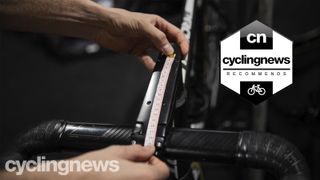
Head tube angle
Seat tube angle.
The most crucial factor when buying a bike is to make sure the frame fits. Just like how you might wear a size 10 shoe in Nike and a 10.5 in Adidas, there is no standardisation when it comes to bike frames, and sizing can vary drastically from brand to brand. Worse, trying to decode a geometry chart for some can be as hard as wrapping their heads around quantum physics.
While minor adjustments can be made with stem length and saddle setback, ultimately if a bike frame is too big or small, the amount of available adjustment won't be great enough, and it will influence the bike's handling characteristics as well as cause issues when it comes to comfort. This is especially true when riding one of the best road bikes because you will essentially maintain that same position for the duration of the ride, and if it’s wrong, you’re in for many hours of pain — the bad kind, that is.
What makes things even more complicated is that people are built differently; some people have short torsos and long legs, while others have a long torso and short legs. This means two people who are the same height might not fit on the same bike.
While we can’t offer a specific chart that will tell you exactly what size frame will be perfect for the dimensions of your body, what we can do is help to demystify the numbers on the geometry chart and show you how to use them to figure out the right size for you.
Luckily, the components on a bike do allow for a little bit of leeway. Saddles usually have around 7cm of fore-aft adjustability, stems can be swapped for shorter or longer versions with shallower or steeper angles that raise or lower the handlebars, and most of the best road handlebars can be bought in a choice of around five different widths. Cranks can be swapped for shorter or longer lengths, many seatposts are available in a couple of shapes that adjust their bend, known as 'layback', and some bikes even come with flip chips that adjust the geometry.
However, don't think that gives you a free ride when deciding which size bike you need. Just like how a house with poor foundations will fall, if your bike's foundation - the frame - is incorrect, you're setting yourself up for a bad time.
Bike geometry
You can trust Cyclingnews Our experts spend countless hours testing cycling tech and will always share honest, unbiased advice to help you choose. Find out more about how we test.
A geometry chart comprises measurements of almost everything to do with the frame. Some of these numbers are extremely helpful in gauging whether a frame will fit your body or not, while others can be ignored entirely. Here's a rundown of the important numbers, and what they mean.
Top tube length and effective top tube length
When we request bikes in for review, the first figure we look at is the top tube length or, more often, the effective top tube length. This is the length from the head tube to the seat tube and is the measurement most brands base their sizing around.

The top tube and effective top tube length can differ because of the modern compact or semi-compact geometry bikes. Old school road bikes see a completely horizontal top tube, while the top tube on most modern bikes slopes downward. This can increase the length of the physical section of tubing but does not increase the actual distance between the head- and seat tubes.
The top tube relates directly to your arm and torso length, and it is a figure that doesn’t leave a ton of leeway to be fixed. If you have a bike with a top tube that is too short or too long, small deficits can be remedied with a new stem of different length. Realistically there is about 20mm of leeway shorter or longer than a stock road bike stem, any longer or shorter, and you will drastically change the handling characteristics of your bike.
Reach is a slightly more difficult measurement to get your head around and refers to the horizontal distance from your bottom bracket to the top of the head tube.
If you were to draw a line from the centre of the bottom bracket straight up through the frame and one from the centre of the head tube back; 'reach' is the horizontal distance between the head tube and the vertical line.
Reach is the key measurement for mountain bikes as the majority of your time on the bike will be in a standing position, with your saddle well behind your body, making the length from the head tube to the seat tube somewhat irrelevant — because you’re not actually sitting on the seat.
For road riders, reach tells us exactly how far you have to ‘reach’ to grab the handlebars and is not subject to wonky measuring and sizing practices between brands. Because of this, it is one of the two key figures to determine how one bike compares to another.
For example, a Trek Emonda has a reach of 386mm in a size 54cm frame, a Specialized Tarmac SL7 has a reach of 387mm also in a size 54cm, and a Scott Addict RC has a reach of 389mm in size 54cm. While the difference is only a few millimetres, each one of these race bikes, which are supposed to be the same size, are actually a little bit different.
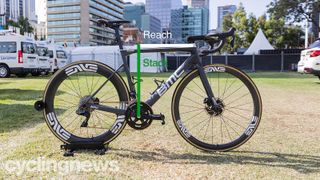
Stack is the other key sizing figure which denotes the vertical distance between the bottom bracket and the centre of the head headtube — measured using the same imaginary line that we drew straight up out of the bottom bracket when we measured reach.
The frame stack height measurement tells us how upright or aggressive a rider's position will be on the bike. Racers tend to prefer a shorter stack because it allows them to get their handlebars low to remain lower, more aerodynamic, and shift more weight over the front wheel for cornering. Endurance and beginner riders are usually better suited to taller stacks because it allows for a more upright, comfortable position.
Small adjustments to the overall stack height can, of course, be made by using angled stems and spacers, but again, this is not unlimited.
For example, Cannondale’s endurance bike, the Synapse, has a frame stack of 570mm in size 54, while the SuperSix Evo race bike measures 554mm in the same size.
Other important measurements
When choosing the right size for you, the measurements above will be the go-to numbers, however, if you find yourself between sizes, or you want to choose between two similar-sized bikes from different manufacturers, the following measurements can help when it comes into the nuanced differences that will affect the ride feel, stability, handling and more.
Seat tube length and standover height
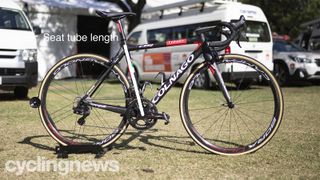
Seat tube length is one of the more simple measurements on a bike and is the distance between the centre of the bottom bracket to the top of the seat tube (excluding the seatpost, which is adjustable, of course).
In the olden days, bikes were sized based on their seat tube length because it was usually the same as the top tube length; this was before the introduction of sloping top tubes and compact frame geometries. While a select few brands, like De Rosa, still size their bikes based on seat tube length, most use the top tube length, if they haven’t opted for t-shirt style small/medium/large sizing.
Seat tube length is still relevant, however, as it provides an insight into a bike's standover height. Too high a standover height, and your bike may leave you with a bruised undercarriage when you stop and climb off. There really isn’t such a thing as too low a standover height; modern mountain bikes are the perfect example of this. That said, as seat tube length and standover height are proportional to the rest of a bike’s geometry, it may signify the need for a bigger frame.
The head tube angle of a bike doesn’t actually tell us anything about the size of a bike, but instead provides an insight into its handling characteristics; although as with everything else, it's not the only determining factor. Fork rake, trail, stem length, handlebar width, chainstay length, and even BB height and drop all affect how a bike handles.
A steeper head angle will be a higher number, offering sharper, more responsive handling, and delicate inputs can illicit mid-corner line changes. With the handling being so light, bikes with steep head angles can sometimes feel nervous at high speed. A slacker head angle (lower number), on the other hand, will be more stable, especially at speed, but will require a bit more gusto to change your line.
Race bikes generally see head tube angle between 72.5 and 73 degrees, endurance bikes are often between 70 and 72 degrees, and cyclocross bikes usually range from 70 to 71 degrees — of course, there are outliers in every category.

The seat tube angle is, you guessed it, the angle of the top of the seat tube, relative to the centre of the bottom bracket.
Usually, on smaller bikes, the seat tube angle will be a bit steeper as riders with shorter legs need to be closer to the BB than riders with longer legs.
On mountain bikes, seat tube angles have increased dramatically as the geometries have become more progressive to help riders maintain traction on steep and technical climbs. On the other hand, road bikes have remained relatively stable, clocking in around 74-degrees, give or take a few degrees depending on the size and style of bike.
While the seat angle of a frame is set, adjustments can be made via a setback seat post or the fore and aft on the saddle rails. The position you’re shooting for is to have your knee directly above your pedal axle with the crank when your foot is at the three o’clock position.
Bike geometry comparison
One problem we face when buying a bike is that each brand lays out its geometry charts in a different way, and this makes comparing two bikes from two separate brands difficult. Expand that to five bikes from five brands and you can get lost in the numbers in no time.
Thankfully, we clearly weren't alone in finding it a headache, as a few clever people have built tools that simplify bike geometry comparison.
Our go-to choice is Geometry Geeks , where you can simply search for the bikes you wish to select, hit compare, and it will bring up a standardised table that allows you to easily see the differences between your chosen frames. Others such as Bike Insights and Velogic Fit provide a similar solution.
So what does this all mean?
We have thrown quite a lot of general information at you here, and hopefully, you’re better equipped to decode the geometry chart of that new bike you’ve been lusting over.
But how do you take this information and figure out what size bike is right for you? Below is a basic size chart based on rider height to get you within the ballpark.
Bike size guides
Remember, that table is only providing a rough ballpark. To get a better idea of what size bike you need to choose, you should consult the size guides provided by the brand you're looking to buy. Online retailers like Competitive Cyclist, Jenson USA, and Bicycles Online also have pretty good sizing calculators that provide you with a decent starting point. However, even armed with this information, you should still only use it as a guide. The geometry charts are the true determiner of whether or not a bike will fit, and if so, how it will fit.
You will notice that we have only included effective top tube length in the sizing chart above, and have not included the t-shirt style sizing employed by some brands. This is because even among those that use small/medium/large to size their bikes, there is no standardisation. For example, a size M Giant TCR Advanced SL 0 Disc has an effective top tube length of 555mm while size M Ridley Helium SLX disc has a top tube length of 565mm — the size small has an effective top tube of 545mm. If you look at our basic size chart above, these fall into two different height categories. So if you are 5ft 9in tall, like this writer, you would ride a size M Giant and a size S Ridley.
The best way to find out if a bike fits is to go down to your local bike shop to try a few out and see what feels right. If possible, go and get a professional bike fit before you pull the trigger, or at the very least, get your local bike shop to help you choose the right size.
If you want to maximise your comfort and efficiency, our bike fit guide explains all the areas that can be adjusted to improve your comfort. Alternatively, a professional bike fit on your own bike will help you to dial everything from your saddle height to how many spacers you need down to the millimetre.
Now you've got the tools at your disposal, check out our guide to the best road bikes and pick the right bike for you.
Get The Leadout Newsletter
The latest race content, interviews, features, reviews and expert buying guides, direct to your inbox!
Based on the Gold Coast of Australia, Colin has written tech content for cycling publication for a decade. With hundreds of buyer's guides, reviews and how-tos published in Bike Radar, Cyclingnews, Bike Perfect and Cycling Weekly, as well as in numerous publications dedicated to his other passion, skiing.
Colin was a key contributor to Cyclingnews between 2019 and 2021, during which time he helped build the site's tech coverage from the ground up. Nowadays he works full-time as the news and content editor of Flow MTB magazine.
Cycling Meets Sailing: The Rise of Cyclors in the quest for the America's Cup
Castelli releases new gravel jersey with built in hydration bladder pocket
How to watch the 2024 Giro d'Italia
Most Popular
Bike Frame Size Chart
Trek Bike Size Charts
By bicycle type:
Trek Mountain Bike Size Chart
- Trek Road Bike Size Chart
Trek Hybrid Bike Size Chart
By bicycle model:
- Speed Concept
- Supercaliber
These charts are based upon official Trek website sizing guide for hybrid & city, MTB and road bicycles. Take the charts below as a general guide and check the sizing calculator on the Trek's website for official results.
The Trek bike size chart, taking into account both height and inseam measurements, offers cyclists a comprehensive guide to selecting the perfect bike size for their body proportions. By considering both of these factors, riders can ensure an optimal fit and maximize their comfort and performance on the bike. Height and inseam helps determine the frame size. This chart enables cyclists to find the ideal frame size, for a comfortable riding position. With the Trek bike size chart by height and inseam chart, cyclists can confidently choose a bike that suits their body measurements and enhances their cycling experience.
Most important difference in mtb frames is the frame full suspension or hardtail. Trek offers bikes from both categories and have even more mtb bike types to offer.
Trek Road Bike Sizing
Trek road bicycles are being made in four different categories, depending on the riders needs. Aero road bikes have excellent aerodynamics and they are the choice for riders who are looking for speed and performance. Lightweight road bikes are excellent climbers and all-around bicycles. Endurance road bikes are built for those riders who spend a lot of time in the saddle, their intended use is to make riders as much as comfortable as possible during the long hours of riding. Gravel road bikes are for use on gravel and dirt roads.
Hybrid, as name states, brings a mixture of a road bike and mountain bike. They tend to have narrower tires than mountain bike and usually they have a front suspension (but sometimes comes with rigid fork too). Hybrid frames falls into the specific category between road and mtb bikes. They never come with drop bar, which differs them from road bicycles. They are ok choice for commuting and excellent one for casual fitness riders.
City bikes, as their name say, are intended for urban use on paved, asphalted roads. Main use is for transport and not for recreational riding.
Trek Domane Size Chart
Trek madone size chart, trek emonda size chart, trek checkpoint size chart, trek speed concept size chart, trek marlin size chart.
For models: Marlin 2, Marlin 4, Marlin 5, Marlin 6, Marlin 7 and Marlin 8

Trek Supercaliber Size Chart
Trek slash size chart, trek dual sport size chart.
For models: Dual Sport 1, Dual Sport 2 and Dual Sport 3
Trek FX Size Chart
For models: FX 1, FX 1 Stagger, FX 1 Disc, FX 1 Disc Stagger, FX 2 Disc, FX 1 Disc Stagger, FX 3 Disc, FX 3 Disc Stagger, FX Sport 4, FX Sport 5, FX Sport 6, 7.1 FX, 7.2 FX, 7.3 FX and 7.4 FX

Join our Email List
Subscribe to our mailing list.
Oversize Charges
Some of our large and/or heavy items are subject to additional oversize charges that are separate from standard shipping costs. Most Bikes are subject to this fee. Learn More

OPEN: Mon, Sat 10-5; Tues - Fri 10-6; CLOSED: Sun
- Account Account
- Stores Stores
- Subtotal : $ 0.00 Checkout Cart

What size bike should I get?
We’ve compiled an extensive guide to bike sizing that makes figuring out the right size a whole lot easier. Below you’ll find great info on how different bikes are sized and how to find the best fit for men, women, and kids. Consulting a bike shop is always the best way to get the best fit, but this article will help you get a good idea of where you sit.
Read on for the full story or use the table of contents or navigation buttons to skip to specific sections.
Table of Contents
- Adult bike sizing vs kids bike sizing
- Women's bike sizing
Road bike sizing vs mountain bike sizing
Important info about bike size charts, when to size up or down on a road bike, mountain bike wheel size for height, when to size up or down on a mountain bike, other mountain bike size naming conventions, why mountain bike sizing varies across brands & generations, what to do if you're in between hybrid bike sizes.
- When to do if your child is in between kids bike sizes
Standover Height
Leg extension, bike sizing faqs.
Table of Contents Road Bike Size Chart Mountain Bike Size Chart Hybrid Bike Size Chart Kids Bike Size Chart Proper Bike Fit Bike Size FAQs
How do you figure out your bike size?
Bike sizing can be a bit of a pain sometimes because there isn't always one universal system of measurement that’s the same for all types of bikes and all riders.
Depending on whether you’re looking for an adult bike, a kid’s bike, a road bike, or a mountain bike, you’ll need to find out what your frame size or wheel size is.
We always recommend heading into your local bike shop to get the best possible fit, but you can also you the size charts and information in this guide to find the size that's best for you.
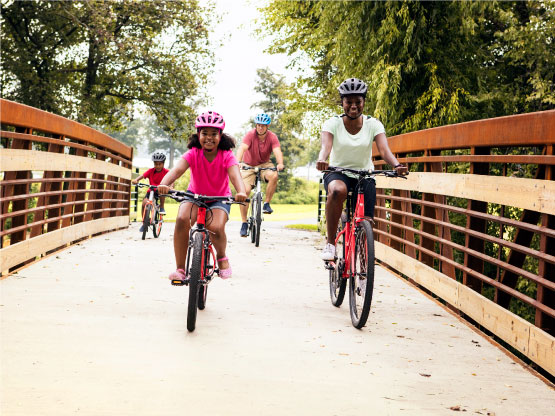
Adult bike sizing vs kid bike sizing
In a nutshell, adult bikes are sized by the frame, and kids bikes are sized by the wheel.
That means that there are two completely different measurement systems between adult and kids bikes. As children grow they’ll obviously start to fit on small adult bikes, but generally, kids 12 and younger will fit on bikes that are measured by the size of the wheels.
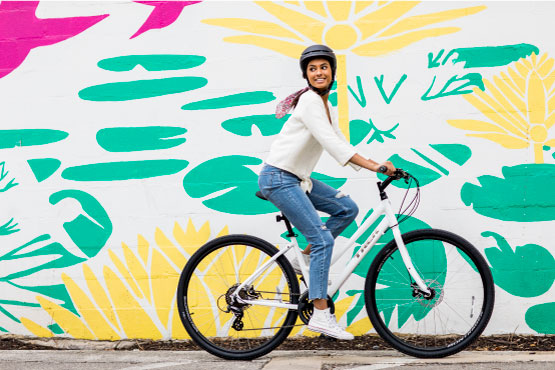
Women’s bike sizing
While some companies offer women-specific models with designs that aim to incorporate better-fitting components, there is no substantial difference between men’s and women’s bike sizes. Both women and men can use the same adult bike size charts below to find a great fit.
To make matters a little more confusing, sizing can also vary between styles of bike or the company that makes them. For example, road bikes and mountain bikes will often use different numbers to designate sizes.
Without going into too much detail, bike size used to be determined by measuring specific parts of the bike, like the seat tube. However, over time manufacturers have decided to update their measurement system since bike geometries have changed considerably. The goal was actually to make it easier for people, but since some companies still stick with the old systems, it can be a bit puzzling.
In the sections below we have broken down a few size charts for road bikes, mountain bikes, hybrid bikes, and kids bikes. It’s important to note that there is no single bike size chart that is universal to all brands or styles. Many bike manufacturers differ slightly in their sizing, but the charts below will give you a good idea of where to start.
Road Bike Size Chart
Road bikes will often use measurements in centimeters to denote frame sizes. If you’re looking at a road bike and you don’t know what size it is, start by measuring the seat tube, as that will give you a good ballpark idea.
Shop Road Bikes
Are you in between road bike sizes on our chart and unsure which way to go? Here are some points to consider:
Size up on a road bike if:
- you have long arms (your wingspan is larger than your height)
Size down on a road bike if:
- if you're mostly concerned with having a bike that's lighter and stiffer (sprinters)
- if you prefer an upright riding position
Mountain Bike Size Chart
Mountain bikes will either be measured in inches or, more likely, in a consumer-friendly Small/Medium/Large hierarchy. Newer mountain bikes can be tough to size without the help of a sticker or stamp on the frame, as geometries have changed so much in recent years that measuring tubes won’t typically give you very good insights.
Shop Mountain Bikes
When choosing the wheel size for your next mountain bike, you'll want to take your height and your preferred riding style into account. It's true that smaller riders often feel more in control on smaller wheels, but depending on your level of experience and the desired ride characteristics, that may or may not be the best way to go for your specific goals.
If you're a beginner, go with the first option on the suggested wheel size portion of the above chart. If you're an advanced rider, you might consider the other listed option and decide which wheel size will suit your riding style best.
As a rule of thumb, larger wheels have faster top speeds and roll over obstacles easier, while smaller wheels are more maneuverable and "playful". If your trail priorities are speed and efficiency, go with a larger wheel size. If your priorities are agility and playfulness, you might really enjoy a smaller wheel size.
Trek recommends riders go with the largest wheel size they can comfortable handle. We'd add to that by saying the best way to get a feel for what's comfortable for you is to come test ride a bike!
Are you in between mountain bike sizes on our chart and unsure which way to go? Here are some points to consider:
Size up on a mountain bike if:
- you're a more aggressive rider who appreciates a longer reach
- you prefer stability on descents to maneuverability
- you like to ride over and through obstacles rather than around them
- your wing span is greater than your height
- you are flexible and better at maneuvering your body to adjust to terrain
Size down on a mountain bike if:
- you prefer to ride more upright
- you riding style is more conservative than aggressive
- you prefer maneuverability over monster truck-like plowing power
- you are less flexible and tend to ride in a similar position
It's important to point out again that not all manufacturers use the same frame size naming conventions. Some brands prefer to "simplify" their sizing to numbers from 1 - 6 (instead of XS - XL) for example. The thing to keep in mind is that not all brands are sized the same, and it's important to look at the size charts provided by the brand you're looking at, as well as the bike's geometry chart, in order to get the best fit.
In the early days of mountain biking, we used to size MTBs by the lengths of their seat tubes, as that would give someone a pretty good idea of what the standover height for a bike would be. That worked for a while, when frame design was relatively straightforward with top tubes and geometry that were more similar to road bikes.
As mountain bike design evolved, manufacturers were able to find more capable performance with different tube lengths and angles. With longer, more sloped top tubes and dropper post-ready designs (and more variations across brands), the seat tube is no longer the best way to approximate a bike's size. This paved the way for brands to start their own sizing methods.
Hybrid Bike Size Chart
Hybrid bikes like commuters and fitness bikes are great all-arounders that are extremely versatile and often very affordable. Most hybrid bikes use a Small/Medium/Large measurement system, but you might find a few companies who still use inches as the size denotation.
Shop Hybrid Bikes
Go with the larger size if:
- you have long arms (an arm span that's longer than your height) or long legs
- the larger size has larger wheels and you prefer larger wheels
Go with the smaller size if:
- you have a longer torso but an average or shorter arm span/inseam
- you have bad hips or a bad back or other mobility issues
Kids Bike Size Chart
As we stated above, kids bikes are measured by the size of their wheels, and it’s much more straightforward than adult sizing. A 12-inch bike has 12-inch wheels, a 16-inch bike has 16-inch wheels, and so on. Here is a great general kids bike size chart to get started, but it’s always best to have your child try a bike before you buy it.
What to do if your child is in between kids bike sizes
Go for the larger size if:
- they feel confident on the bigger size
- they're getting into racing or biking as a sport
Go for the smaller size if:
- they're less confident riders
It's almost always better to size up with kids bikes, but only if they can actually handle the larger size. Kids grow up fast, and as a parent you'll want to try to give them a bike that they can ride for at least a few years, not just one.
There are some exceptions, though. Go too big and they may not be able to control the bike, which is more dangerous and certainly less fun. Kids will become better riders when they're riding a bike they feel confident on.
How to check if a bike is the right size
Let’s say you’re standing in front of a bike that you’re interested in buying and you even know what size bike it is. According to all the size charts, the bike should be about right, but how do you know for sure? And what if you’re right on the line between two sizes? Read on to learn some of the most important things to consider when looking for the perfect fit.
Important: getting the right fit on a bike is just as important as choosing the right size frame. If you're feeling unsure or experience pain when you ride, you should consider brining your bike to a shop. The Bike Shoppe can help! Explore our bike fitting services .
Standover height is essentially the distance between the top tube and the ground at the point where you stand over the bar. This is an important measurement to get right because you’ll want some space between your groin and the bar when you hop off the seat. For most bikes you’ll want an inch or more of standover room for a super comfortable fit. You can easily test this by pulling the bike up until it touches your body when you’re standing. If you can pull the wheels up an inch or more, you should have plenty of space.
After you’ve made sure you have enough standover room, you’ll want to make sure your legs have the proper amount of extension. You can adjust the seat height to get the right fit, but if you’ve jacked the seatpost up to the max and your legs are still very bent when you pedal, you might need a bigger size.
Here’s how to get proper leg extension:
On the downstroke, or when the pedal is closest to the ground, you should look to have around a 15-20° bend in your knee. Depending on the person you may prefer more or less bend, but you want to avoid having your knees come up too high when you pedal, which is uncomfortable, inefficient, and bad for your joints.
Another way to check your leg extension is to put your foot on the pedal and see if you can lower your heel below the axle of the pedal on the downstroke. If you can push your heel a little further than the axle, that’s often an optimum position in terms of efficiency and comfort.
Reach is pretty much what it sounds like. Specifically, the official reach measurement is usually the horizontal distance between the bottom bracket and the head tube. More generally, it translates to how far you have to reach to grab the handlebars.
Reach is something to consider mostly when you’re an experienced rider and you’re in between two sizes. Selecting a bike with a longer reach will feel “roomier”, more stable at speed, and generally more confident on technical terrain. A shorter reach will help the bike feel more responsive, but depending on what kind of riding you do, that may or may not be what you’re after.
What size bicycle is right for my height?
Before you think about what size bike you are, you’ll want to decide what kind of bike you want. As we state in the article above, road bikes and mountain bikes often use a different sizing system, so figure out what style you’re looking for first, then consult the charts above.
Should your feet touch the ground on a bike?
Ideally you should be able to touch your toes to the ground when sitting on the seat, but if you can put your feet flat on the ground it often means that your seat height is too low. If your seat is too low, your knees will be overly bent when pedaling and that can cause discomfort and joint pain, not to mention it’s not a very efficient way to ride.
If you feel more comfortable with your feet flat on the ground, check out Electra bikes. They use something called Flat Foot Technology which is a frame design where the pedals are moved forward on the frame so you can get proper leg extension while pedaling but still put your feet flat on the ground when you want to.
Shop Electra Bikes
Should your legs be straight when riding a bike?
How much does a bike fitting cost.
Explore Bike Fitting Packages
Do I need a 26 or 29 bike?
26-inch wheels were the mountain bike standard in the past, but most mid and upper tier mountain bikes you’ll see on the market today use either 29-inch wheels or the slightly smaller 27.5-inch wheels. 29ers and 27.5+ bikes have faster top speeds and roll over obstacles easier than 26-inch wheels, so if you want to ride off-road, you’ll appreciate bigger tires. 26-inch wheels are often great for kids who have graduated from their 24-inch kids bike but aren’t quite big enough to use the bigger wheels found on most adult bikes.
What size bike does a ____ year old need?
What size is a 26 inch bike.
The 26 in a 26 inch bike refers to the wheel size, so that measurement isn’t always the best way to judge how big a bike is. Some youth bikes are measured by this wheel size, but more commonly you’ll find 26-inch wheels on a variety of adult frame sizes.
Shop 26-inch bikes
Is a 26 inch bike for adults?
In short, yes! 26-inch wheels are used on adult bikes and have been for years. That being said, most modern mountain bikes have switched to 27.5” and 29” inch wheels for their superior speed, traction, and rollover power. However, 26 inch wheels are super strong and universally available, so bike tourers often use them for traveling abroad.
- MAGAZINE OFFERS
- BIKE INSURANCE
- Best Products
- Maintenance
- Accessories
- Long-Term Reviews
- BikeRadar Podcast
- First Look Friday
- Bike of the Week
- Tech Features
- Routes and Rides
- Bike Galleries
- BikeRadar Bargains
- Buyer's Guides
- Fitness & Training
- Sizing & Fit
- Mountain Biking UK
- Cycling Plus
- Bike of the Year 2024
How to measure a bike frame: our complete guide to sizing a bike
Fundamental measurements so you can compare frames like-for-like
Simon Bromley / Immediate Media
Paul Norman
If you’re thinking of buying a new bike, or a first bike, understanding the key measurements that define your frame is important to ensure you get a machine that fits you and works for the type of riding you intend to do.
And if you’re planning to rent a bike, it’s useful to know your frame’s key measurements, so you can make sure your rental will be comfortable to ride and can be adjusted to fit.
Not all manufacturers measure frame sizes in the same way, so you need to look at a few fundamental measurements to ensure you’re comparing apples with apples.
Read on to find out how to size up your road bike or mountain bike frame to ensure you get the right bike fit . Also check out our comprehensive guide to mountain bike geometry , which tells you how these measures affect handling; even if you’re a roadie, most of the measurements are still as significant.
We’ve also got advice on how to choose the right size frame for road bikes and mountain bikes and specific advice for choosing a women’s bike .
Bike geometry measurements
We’ll tell you below how to measure the key numbers that define your bike. But first, here’s a quick rundown of those numbers:
- Top tube length: the horizontal distance between the centreline of the head tube and seatpost
- Seat tube length: the distance between the centre of the bottom bracket and the top of the seat tube
- Reach: the distance between the bottom bracket and the top of the head tube
- Stack: the vertical distance between the bottom bracket and the top of the head tube
- Wheelbase: the distance between the front and rear axles
- Chainstay length: the distance between the bottom bracket and rear dropout
- Front centre: the distance from the bottom bracket to the front axle
- Seat tube angle: the angle of the seat tube in relation to the ground
- Head tube angle: the angle of the head tube in relation to the ground
- Bottom bracket drop: the difference between the height of the wheel axle and crank axle
- Bottom bracket height: the distance from the ground to the bottom bracket
What you’ll need to measure a bike frame
To measure a bike frame you will need four tools:
- A tape measure
- A clinometer to measure angles (there are free smartphone apps you can download)
- A long spirit level (or you can use the clinometer app and a straight piece of wood)
- A plumb line (or you can improvise with string and a couple of blobs of Blu Tack)
Most bikes, whether road or mountain, are now measured in metric units, but you may find some manufacturers that still size mountain bikes in inches. Some brands, such as Moots, even mix the two.
We highly recommend you stick to metric units to keep things consistent. If you really must, you can always divide centimetres by 2.54 to switch to inches.
You will usually be able to find a geometry chart for all sizes of a current frameset on a maker’s site. If your bike is still a current model, it’s worth taking a copy of this because it will be more accurate than your measurements and likely a handy reference down the line.
How to measure top tube length
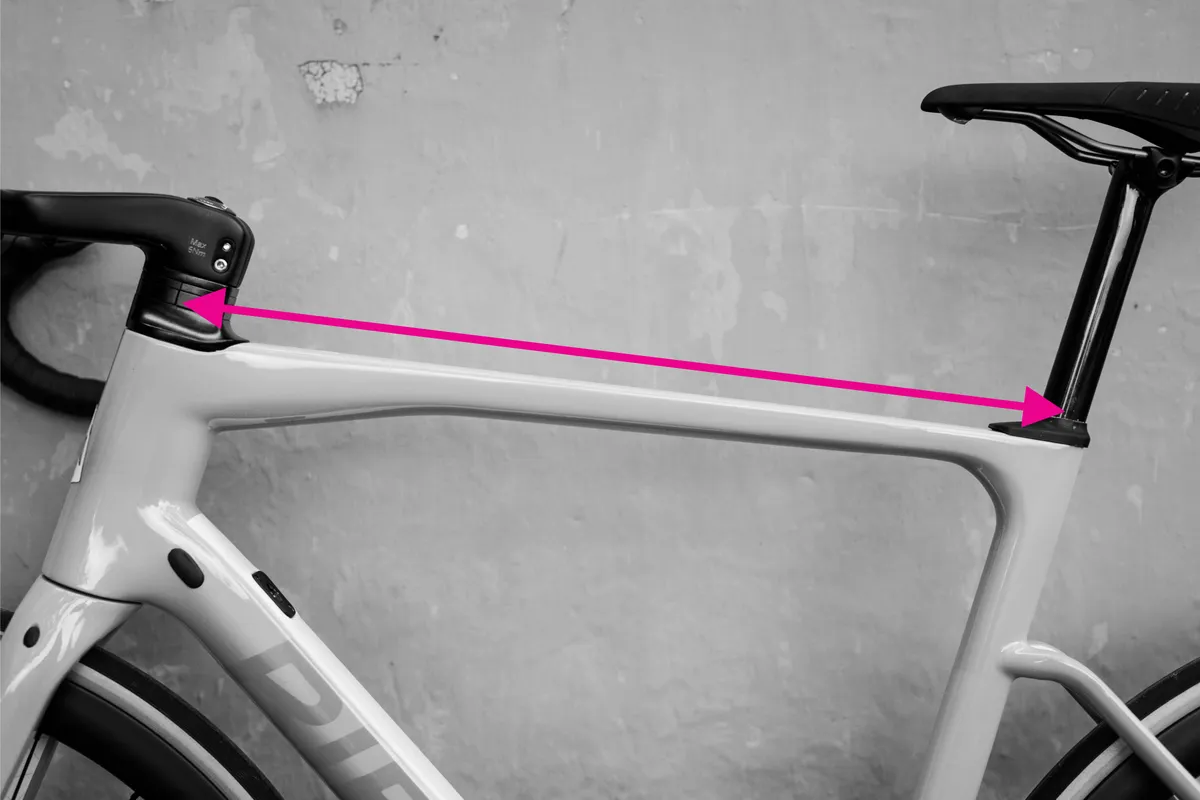
Once, bikes all had horizontal top tubes. Now many bikes’ top tubes will have a slope.
If you look at a bike geometry table, it will usually include the real top tube length. But for a consistent measure, regardless of the top tube angle, you need to measure the horizontal top tube length, called the effective top tube length or virtual top tube in many geo charts.
That’s the horizontal distance between the centreline of the head tube and the centreline of the seatpost. Measuring it correctly will mean using your spirit level or the clinometer app, to ensure your measure is really horizontal.
Many manufacturers size road bikes by top tube length. That’s not true of mountain bikes, where the frame size is usually marked S, M, L, etc. That’s a system used for some road bikes too: Merida’s road bikes go through S, S/M, M/L and L.
Of course, this measurement is up to each brand's interpretation – Ridley’s size-S frames have a top tube of around 54cm, which is equivalent to many brands’ size-medium frames.
It’s worth noting that not all brands measure virtual top tube length in the same way either.
Colnago, for example, records the horizontal distance from the head tube to a vertical projected up from the top of the seat tube, so it doesn’t take account of the further backward projection of the seatpost and its numbers will come out smaller than other makers’. A 50s Colnago is equivalent to a 54cm top tube.
How to measure seat tube length
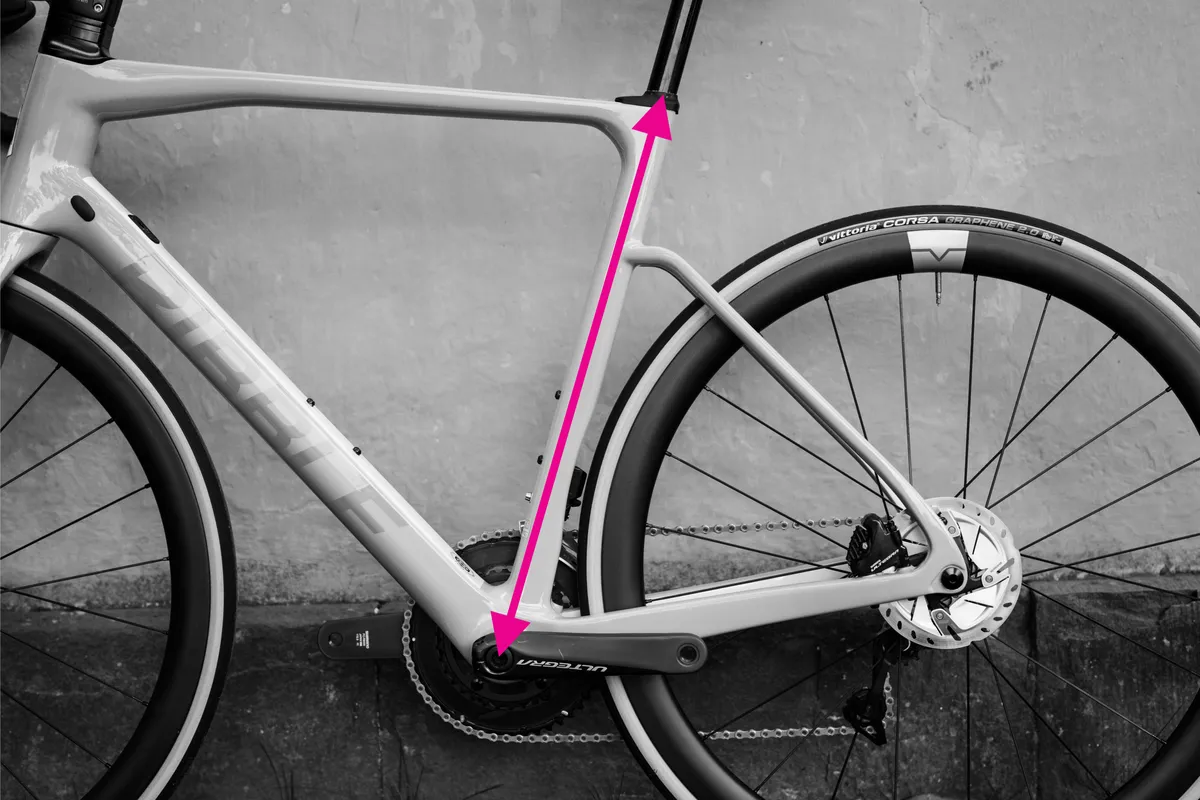
Seat tube length is the straight-line distance between the centre of the bottom bracket and the top of the seat tube.
Again, it’s trickier than it sounds: some bikes such as the Trek Madone have a considerable extension of the seat tube above the top tube junction, while others use a seatmast, so it’s difficult to compare with an alternative’s dimensions.
Plus, mountain bikes in particular often have a kink in the seat tube, so you don’t want to follow the line of the tube itself, which will be longer.
Line up your straight edge with the bottom bracket centre and the top of the seat tube and measure along this, if you’re not sure you’re following the right line.
How to measure reach and stack
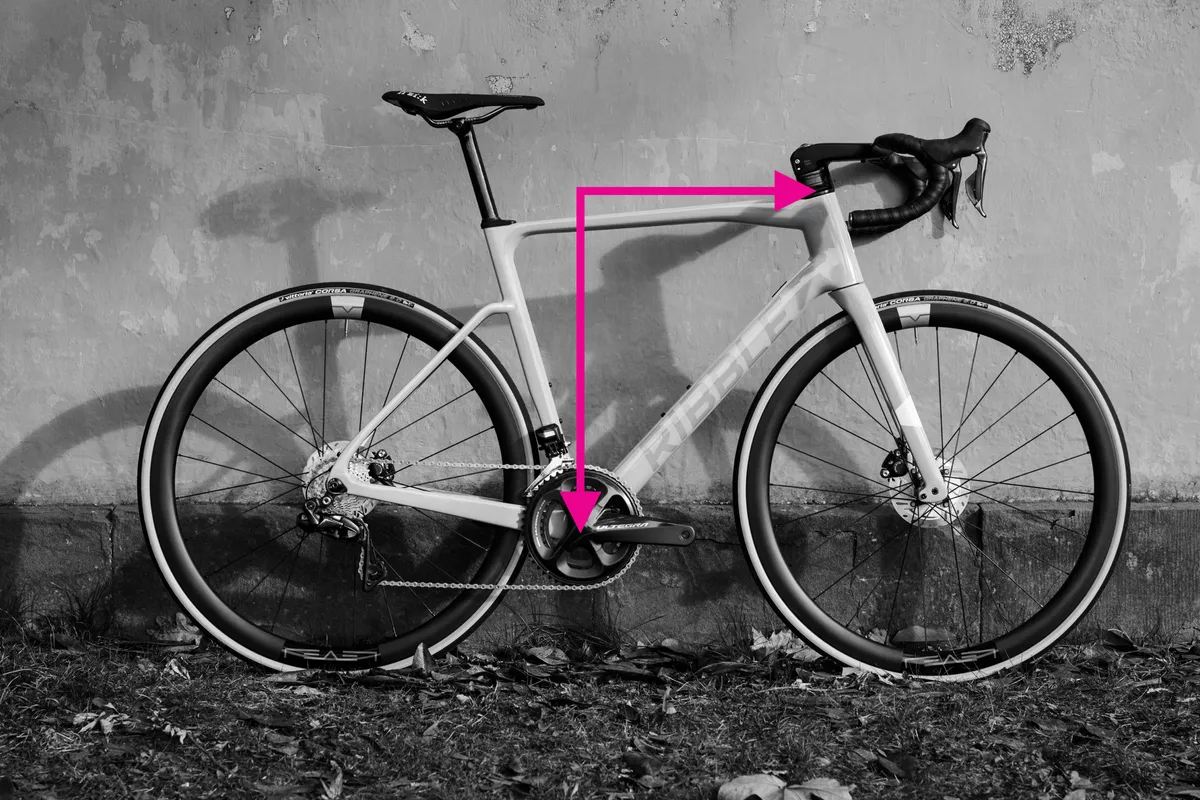
So we’ve seen that top tube and seat tube lengths are a bit of a minefield if you want to compare frames. For more consistency, most manufacturers will now show reach and stack values for their bikes.
These have the advantage of being independent of frame design and measure the perpendicular distances between two key contact points: the bottom bracket and the top of the head tube.
We’ve published a more detailed explanation of why reach and stack are important here .
In brief, the reach is the horizontal distance between the two. To measure it, you’ll need your spirit level again.
Attach a plumb line to the end of the level. If you’re using Blu Tack, make sure the blob at the end of the string is fairly symmetric and your string hangs down straight, otherwise your measure may be off.
Align the top edge of the level with the centreline of the top of the head tube. Then move the level back and forward until the plumb line intersects with the centre of the bottom bracket spindle. Now just measure the distance between the top of the plumb line and the head tube and you’ve got your reach.
Another option is to push your bike up against a wall, measure the distance to the top of the head tube and the distance to the bottom bracket, then subtract one from the other. You’ll still need to make sure your measurement is horizontal though.
The stack is the vertical distance between the bottom bracket and the top of the head tube. So once you’re set up to record your reach, you should also be able to measure your stack, following the plumb line.
An alternative method is to measure the vertical distance from the ground to the top of your head tube, then measure the height of your bottom bracket from the ground and subtract this.
Both reach and stack are quite fiddly to capture. You’ll probably need a second pair of hands if you use the plumb line method and it’s worth repeating to ensure you’re consistent.
How to measure wheelbase

Your frame’s wheelbase is the distance between the front and rear axles. It’s a key determinant of a frame’s ride quality and will vary with frame size too.
It’s fairly easy to measure, although you need to set the fork straight ahead or your measurement will be incorrect.
Like reach and stack, it’s worth repeating the measurement several times to make sure you get the same number. Accuracy will also be increased if you measure the wheelbase on both sides of the bike and take the average because this will compensate if the fork is not quite straight.
How to measure chainstay length
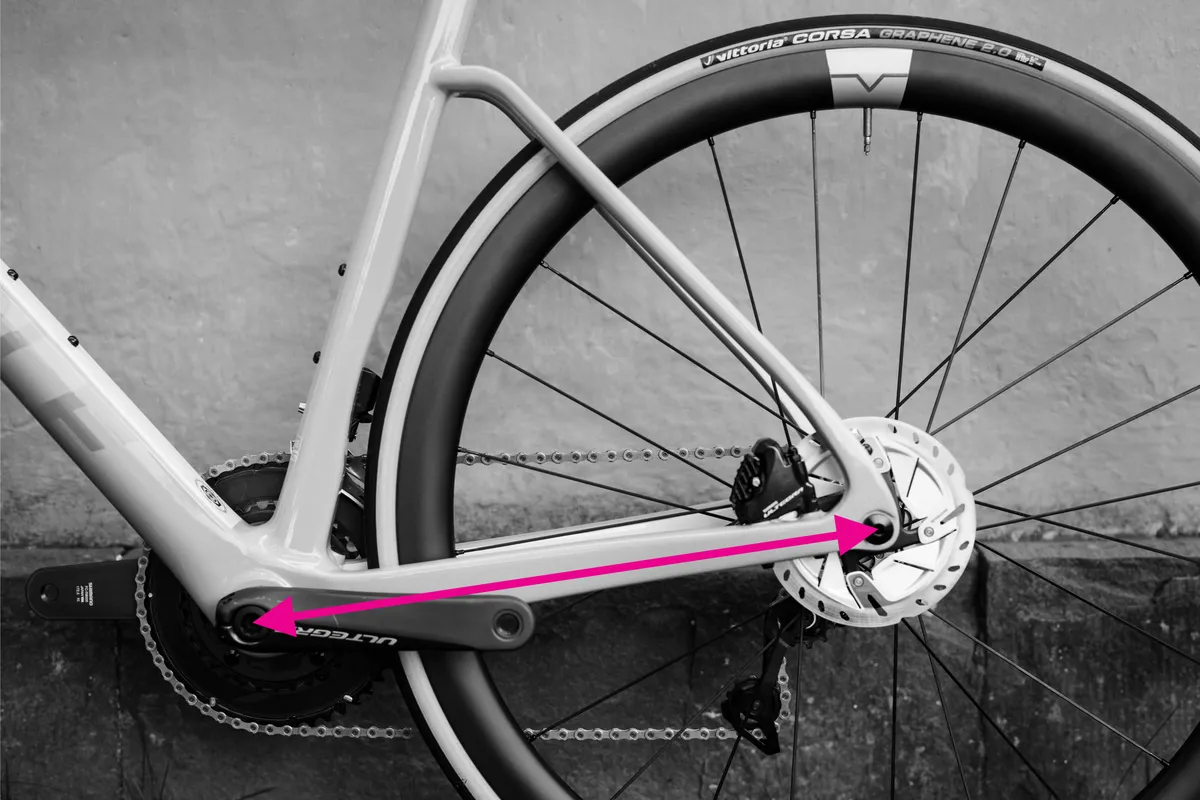
Chainstay length is one of the two components that make up your wheelbase and, again, contributes significantly to your frame’s handling characteristics. A frame with shorter chainstays will typically feel more lively than one where the stays are longer.
The chainstay length is the straight-line distance between the centre of the bottom bracket axle and the centre of the rear dropout, so it’s fairly easy to measure with a ruler.
How to measure front centre

The other component of the wheelbase is the front centre. That’s the equivalent of the chainstay length but measured from the axle to the front dropout.
Again, it affects handling, as well as toe overlap with the front wheel. It’s not often quoted by bike makers, but BMC, for example, shows it on its geometry charts.
Note that the wheelbase is not the sum of the chainstay length and the front centre, because neither of these is measured horizontally.
How to measure seat tube and head tube angles
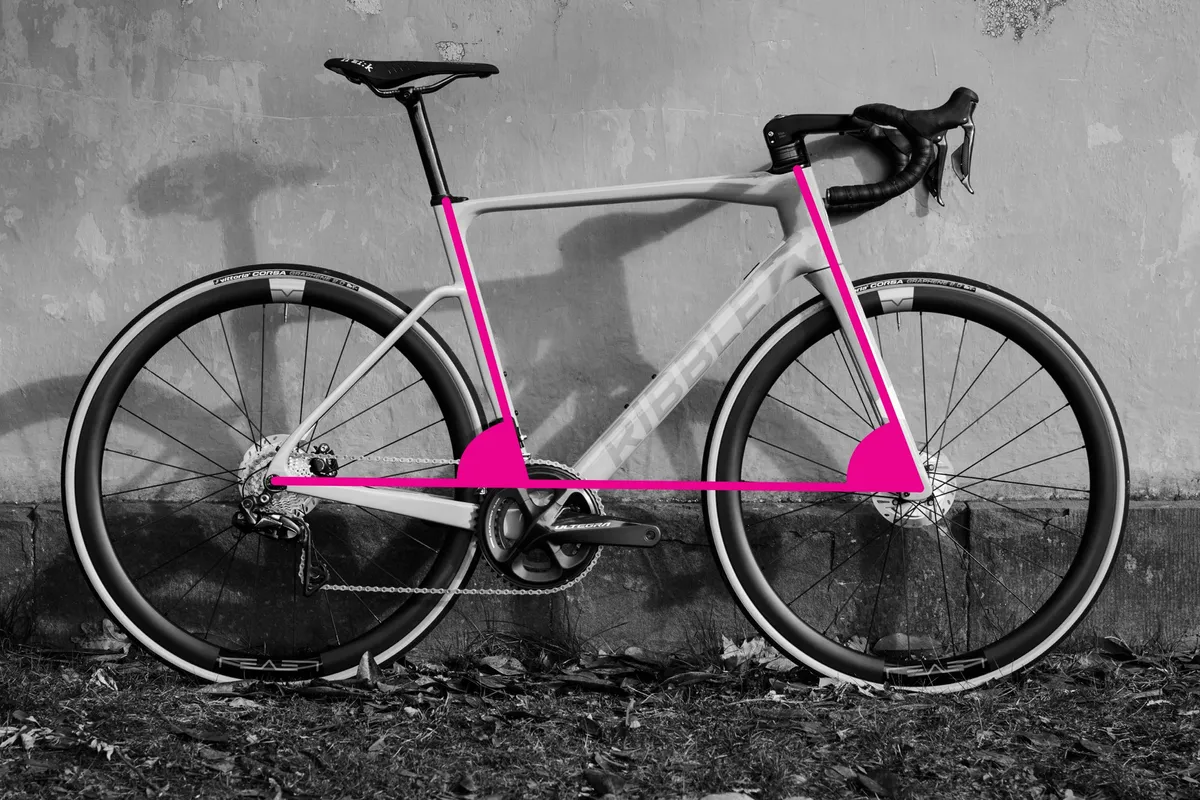
The seat tube and head tube angles are two of the most important factors in determining handling, with more upright tube angles typically leading to more nimble handling. Your clinometer app will come in useful here.
If you’ve got a straight seat tube, you can measure the seat tube angle by lining up your smartphone and reading the number from the clinometer app. Make sure your bike is vertical and standing on a horizontal surface for an accurate reading.
If there’s a kink in your seat tube, you’ll need to use a straight edge to follow the line between the bottom bracket shell and the top of the seat tube, then line up the phone with this.
Most newer bikes will have tapered head tubes, so the angle of the front of the head tube will not be the same as the angle of its centreline.
You can get close to the latter by holding your phone at the angle of the centreline, or by using a straight edge to line up with the centres of the top and bottom of the head tube.
If you have straight fork legs, without an angle at their crown, the angle of the legs will be the same as the head tube angle, so you can measure this instead. Again, it’s important to have the bike standing vertically.
You can also measure head tube angle by lining up the clinometer with the steerer extension above the head tube.
How to measure bottom bracket drop
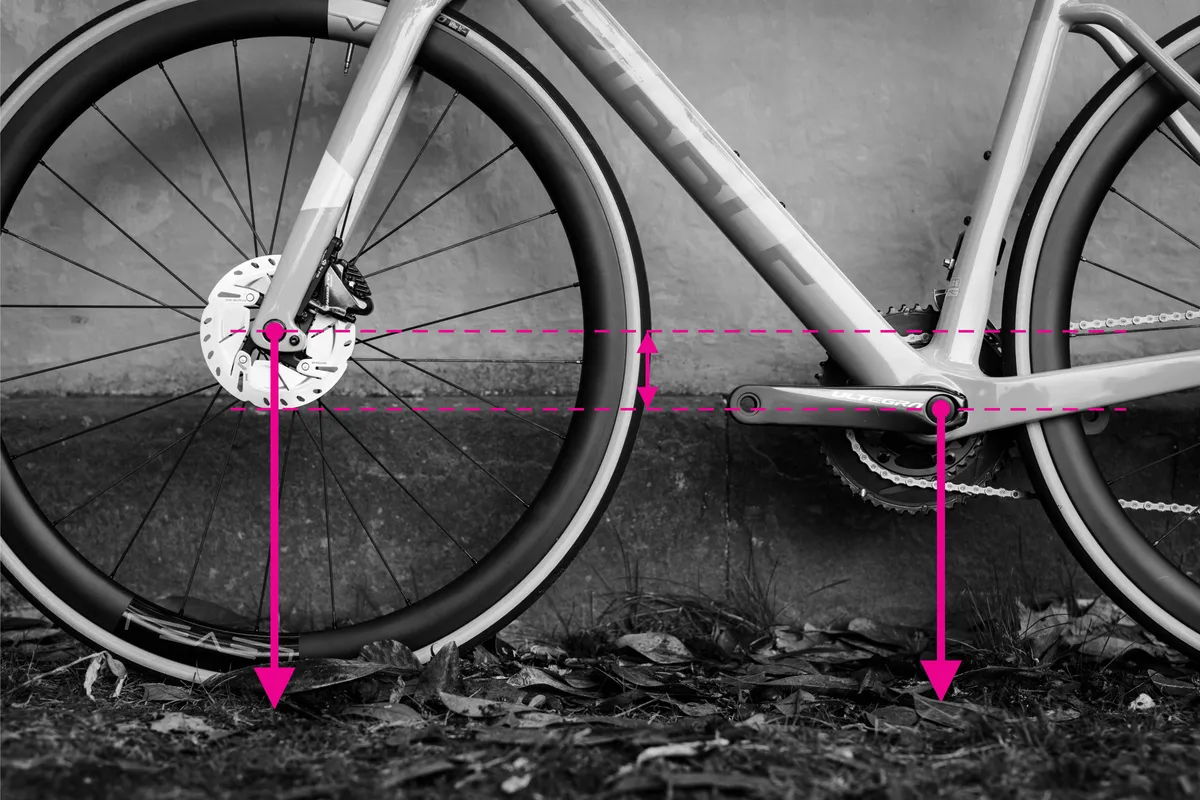
The bottom bracket drop is the difference between the height of the wheel axles and the centreline of the crank axle.
You can measure it by finding the height of the rear axle and the height of the bottom bracket, then subtracting one from the other. It’s another key measurement quoted by bike brands on their geo charts.
How to measure bottom bracket height

Finally, the bottom bracket height is the distance from the ground to the centre of the bottom bracket shell. So that’s quite easy to measure, although be careful to keep your bike straight upright for an accurate reading.
Unlike bottom bracket drop, it will be affected (slightly) by your tyres too, so inflate them to your usual running pressure.
Now you’ve got all the measurements you need to size up your frame, and help with any purchasing decisions in the future, whether that's a new or second-hand road bike, commuting bike or gravel bike . Keep your numbers somewhere safe though: you don’t want to have to repeat the process.
Share this article

You may also like
Bikeradar newsfeed, best gravel bikes in 2024 | top-rated carbon, aluminium, titanium and steel gravel bikes reviewed, the evolution of mountain bikes in two decades | how have trail bikes changed from 2005 to 2023, best bike: our buyer's guide to which bicycle type you should buy in 2024, the ultimate guide to bike geometry and handling.

- Terms & Conditions
- Subscribe to our magazines
- Manage preferences

Unleash Your Inner Geek on a Bike
What Size Trek Bike Do I Need for My Height? Find Your Perfect Fit!
Shahed Parvej

Affiliate Disclaimer
As an affiliate, we may earn a commission from qualifying purchases. We get commissions for purchases made through links on this website from Amazon and other third parties.
As an Amazon Associate, I earn from qualifying purchases.
The size of the Trek bike you need for your height depends on your specific measurements. To determine the correct size, you’ll need to measure your height and inseam.
Use an online sizing tool or refer to Trek’s bike size chart, which provides the appropriate frame size based on your height. If you fall between sizes, it’s recommended to choose the smaller size for a more comfortable and maneuverable ride.
Make sure to consider other factors such as your riding style and preferences when selecting the right Trek bike for you.
Trek Bike Size Guide
Choosing the right size Trek bike for your height is important to ensure a comfortable and efficient riding experience. Understanding Trek mountain bike sizing and road bike sizing can help you make an informed decision. Trek offers a wide range of sizes for their mountain bikes, including an XS size with increased standover height and an ML (medium-large) size.
For road bikes, you can use an online tool to determine the best size based on your height and inseam measurements. If you find yourself between sizes, it’s recommended to size down for a more aggressive riding position or size up for a more upright and comfortable riding position.
Remember to consider factors such as terrain, riding style, and personal preference when choosing the right size Trek bike for you.
How To Measure Your Height For A Trek Bike
Determining the right size Trek bike for your height is crucial to ensure a comfortable and enjoyable riding experience. To measure your height for a Trek bike, refer to the women’s mountain bike size chart. This chart provides sizing conversion and specific frame sizes for different rider heights.
Trek offers various models such as the Trek 820, Trek FX 1, Trek Domane, Trek Madone, Trek Émonda, Trek Marlin, and Trek Slash. Each model has different frame sizes suitable for different heights. Measure your height accurately and match it with the corresponding frame size on the chart.
By doing so, you can find the perfect fit and optimize your comfort and performance on a Trek bike. Whether you’re a casual rider or a seasoned cyclist, getting the right size bike is essential for a pleasurable riding experience.
Trek Hybrid Bike Sizing Guide
When it comes to determining the right size Trek bike for your height, it’s important to refer to the Trek Hybrid Bike Sizing Guide. This guide provides information on the recommended Trek frame size for different rider heights. For someone with a height range of 4’10” – 5’1″, the recommended frame size is 13 inches.
If you fall within the height range of 5’0″ – 5’6″, a frame size of 15 inches is suggested. The recommended frame size for a height range of 5’4″ – 5’10” is 17. 5 inches, and for those with a height range of 5’8″ – 6’2″, the suggested frame size is 20 inches.
By following this guide, you can ensure that you choose the right size Trek hybrid bike for your height.
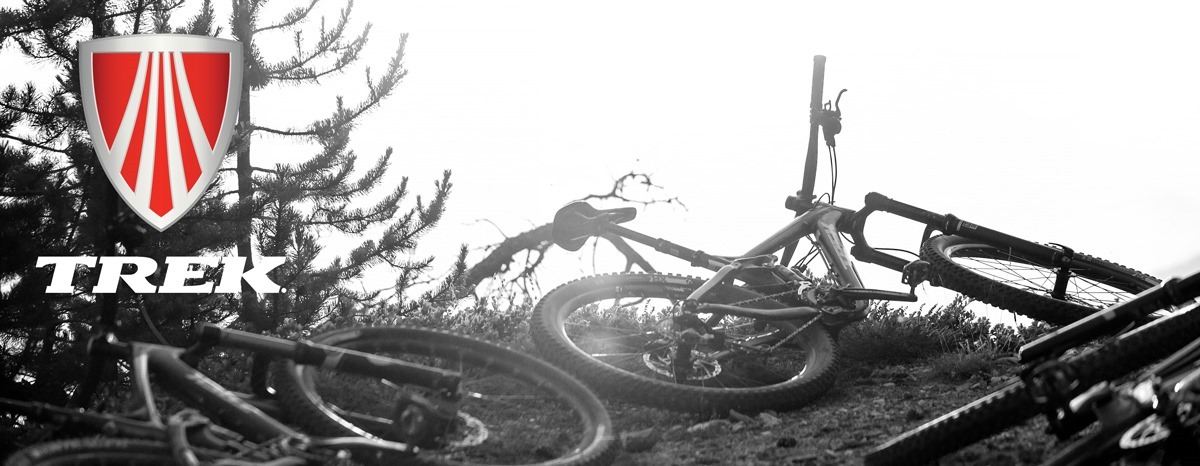
Credit: www.leisurelakesbikes.com
Fit & Sizing Tips For Trek Bikes
Finding the right size Trek bike for your height is crucial for a comfortable and enjoyable riding experience. Trek offers a wide range of mountain bike sizes, including XS with increased standover height and ML (medium-large), to ensure a perfect fit for all riders.
To determine the correct size for you, use Trek’s bike size finder tool, which requires you to measure your height and inseam. If you fall between sizes, it’s recommended to choose the smaller size for a more nimble and maneuverable ride.
Remember, proper fit and sizing are important factors in maintaining good posture, maximizing power transfer, and preventing injuries. By following these fit and sizing tips for Trek bikes, you can ensure a smooth and enjoyable ride every time.
Frequently Asked Questions For What Size Trek Bike Do I Need For My Height
How tall of a bike do i need for my height.
To determine the right bike size for your height, refer to the Trek Bike Sizing Guide. It provides specific frame sizes based on your height range.
What Size Is An 18.5 Trek?
The size of an 18. 5 Trek bike is 20 inches. (9 words)
What Height Is A 26 Inch Bike For?
A 26-inch bike is suitable for individuals with a height range between 5’4″ to 5’10”.
To ensure a comfortable and enjoyable biking experience, it’s crucial to find the right size Trek bike that suits your height. Trek offers a variety of frame sizes to cater to different riders, allowing for a more customized fit. Taking into account your height and inseam measurements, you can use the online tools provided by Trek to determine the ideal size for you.
It’s important to remember that the sizing recommendations provided by Trek are a general guideline, and personal preference also plays a role. Factors such as riding style, flexibility, and intended use should also be considered when selecting the right size bike.
By choosing the correctly sized Trek bike, you can enhance your cycling performance and reduce the risk of discomfort or injury. So, take the time to find the perfect fit and enjoy your biking adventures to the fullest!
About the author

I’m Shahed Parvej, the proud owner and founder of this platform. As a passionate Bike Enthusiast, I’ve embarked on a journey to share my knowledge, experiences, and insights with fellow enthusiasts, newcomers, and everyone intrigued by the world of biking.
Leave a Reply Cancel reply
Your email address will not be published. Required fields are marked *
Save my name, email, and website in this browser for the next time I comment.
Latest posts

Discover the Ultimate Best Bike Brake in 2024 for Unbeatable Cycling Performance
As an Amazon Associate, I earn from qualifying purchases.Looking for the best bike brake in 2024? The shimano xtr m9100 disc brake offers top-notch performance, reliability, and precision, making it a standout choice for cyclists. The importance of a reliable bike brake cannot be overstated, especially when it comes to ensuring safety on the…

Can You Put 27 5 Wheels On A 29Er: Unveiling the Ultimate Upgrade
As an Amazon Associate, I earn from qualifying purchases.Yes, you can put 27.5 wheels on a 29er bicycle as long as the frame and brakes allow for the smaller wheel size. Swapping to smaller wheels can improve agility and maneuverability on rough terrain. It’s essential to consider the impact on the bike’s geometry, bottom…
What is a Wet Bike
As an Amazon Associate, I earn from qualifying purchases.A Wet Bike is a planing motorized watercraft that combines the features of a motorcycle and a jet ski. It is propelled by pump jets, similar to other personal watercraft. The original Wetbike was introduced by Spirit Marine and marketed as a “water motorcycle” with the thrill…
- More Networks

Biketoworkday is supported by its audience. When you buy through our links, we may earn an affiliate commission. Learn more
Bike Sizing Guide: What Size Trek Bike Do I Need?
Written by Gary Johnson / Fact checked by Henry Speciale
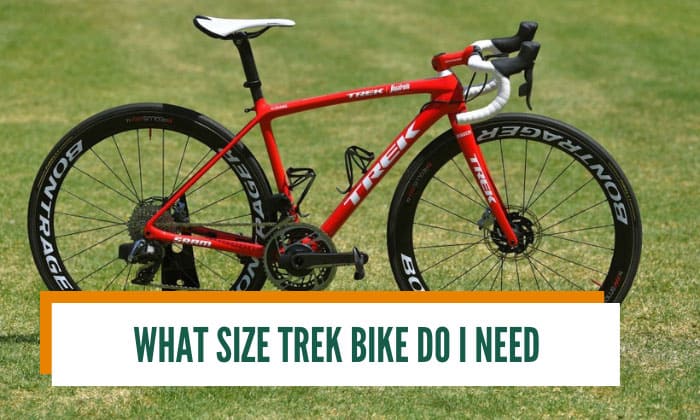
Are you looking for a bike to buy and asking yourself “what size Trek bike do I need?”
Trek bike sizing is very straightforward and varies by type.
For example, mountain bikes follow a unique method called alpha sizing that uses designations such as small, medium, or large. Using this system, a 5’3” to 5’7” tall person can use a 17.5” frame size.
On the other hand, Trek road bike sizing takes into account the inseam length.
If you want to get on the road or hit that trail with your ideal two-wheeler, check out our sizing guides below.
Table of Contents
1. Trek Mountain Bike
2. trek road bike, 3. city & hybrid bike size chart, things you can consider before choosing a trek bike size, helpful tip, trek bicycle sizing guide.
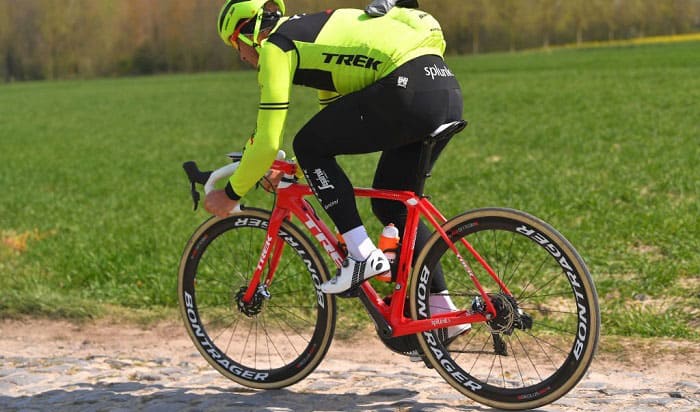
Trek bikes are comfortable and easy to ride, making them excellent for beginners. They also come in different dimensions, so you should find one that fits you perfectly.
Whether in inches or cm, our Trek bike size chart will help you match your height with the appropriate vehicle.
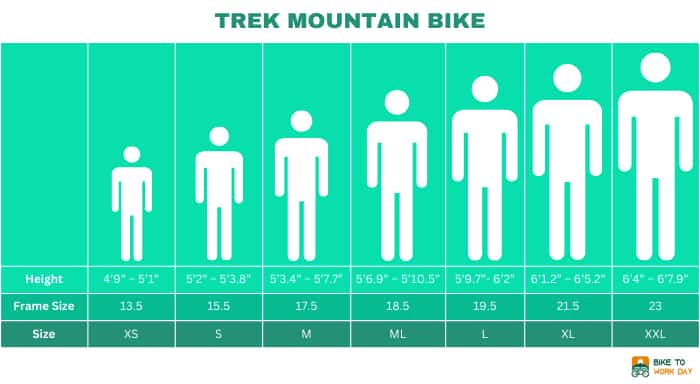
Unlike other brands, Trek bikes have upgraded their MTB sizing with alpha classifications to remove guesswork for customers.
You may find that your chosen model has some and not all of the sizes in this Trek MTB size chart. In that case, branch out and look for XS and XXL options if the Trek M/L frame size doesn’t fit you.
Note that the women’s bike size chart also uses the alpha sizing guide for their line of women’s mountain bikes though the height requirement is slightly different for each size.
Did You Know
The Trek Marlin 5, which is a popular trail mountain bike, uses the alpha sizing chart, but its size is not limited to XS – XXL only! Trek also offers an XXS with 26” wheels for this MTB type.
Trek has given us 4 categories when it comes to road bicycles. These include:
- Aero – The best aerodynamics for speed and performance
- Endurance – Provides comfort perfect for long hours of riding
- Time Trial – Speed-focused bikes with unique designs
- Climbing – Lightweight bikes excellent for uphill climbing
Designed to be a mixture of road and mountain bikes, Trek hybrid bicycles are best used for casual rides and commutes.
What size bike should I get? What does “size” really mean? And what is the best way to find the correct model for yourself?
There are usually FOUR different aspects that you must consider and have a good idea about.
Riding Style

Do you want to ride your bike for fun or use it for racing and exhibition? Regardless of your budget, it is important that you consider the type of biking you want to do. Some people prefer to ride in the city, while others prefer to cycle off-road.
Trek bikes come in various sizes depending on the vehicle’s discipline, since some frames have different geometry to provide the support their riders need.
Rider Height
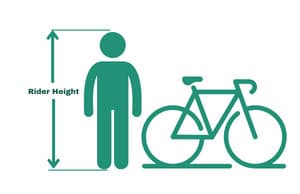
Most bicycle models come in different sizes for different body types so that they fit most people well.
The height of a person, when measured from head to toe, can help determine the bike size that would match them. This is because taller people have longer upper and lower extremities compared to shorter people, which means they will need different sizes of bikes in order to ride comfortably.
Inseam Length

After careful deliberation with the above two factors, the frame size is then ultimately determined by your inseams or the distance from your crotch to the bottom of your leg.
You should take this into consideration because it will determine how much room there is between your feet and handlebars when sitting on the saddle comfortably.
Practical Use /Test Ride

Last but not least, once you have chosen your bicycle size and Trek model, test out the bike with at least a short ride. This will let you assess the balance and comfort of the chosen vehicle.
Whether you ride recreationally or professionally, you cannot choose blindly. First, bikes are expensive, and second, you must buy the correct product to use it for a long time.
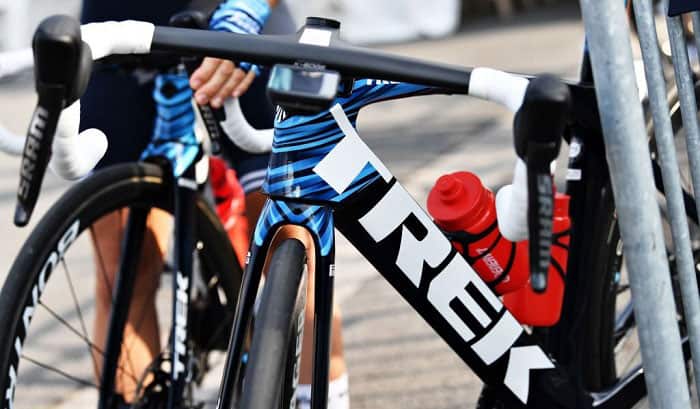
If you’re done with our Trek frame size chart, Trek’s online website also has a unique feature that helps you select the correct frame size. You can try their bike finder, which asks for your riding style, height, and even inseams before arriving at a recommendation.
In case you haven’t noticed, there is a lot of variation in bicycle sizing, and looking for the size I need for my height was not a walk in the park.
Well, I hope our guide answered your question about what size Trek bike do I need. Should you have any more questions, send us a message.
Read more: Choosing the Ideal Bike Size for Your Kids – Bicycle Sizing Guide.

“I ride my bike to work for years, but is that enough? Our carelessness towards our surroundings has taken a toll on the environment. And now, everyone is responsible for changes; even the most minor contribution is counted. With this hope and spirit, I started with my partner to establish Biketoworkday to help more individuals commute to their work sites on their bikes.”
Mountainbike
- TFR Downhill
- TFR Cross Country
- Baloise-Trek
- TFR Triathlon
- Trek Ambassadors
- Regional teams and athletes
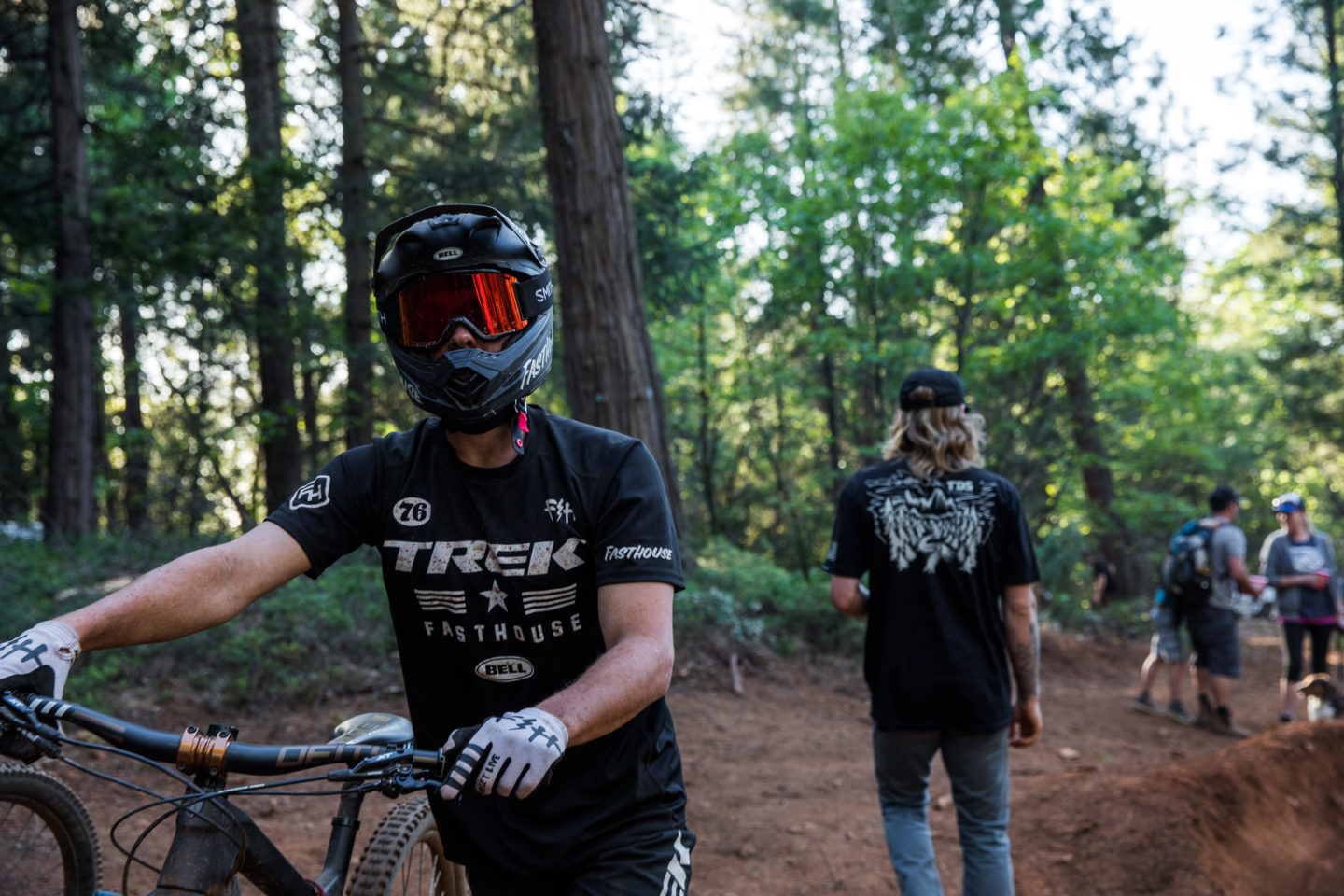
- Lidl-Trek Fanclub
- trekbikes.com
BIKE CHECK: Jonny Milan’s Giro Madone

A closer look at the Madone SLR that is capable of keeping up with the power of the Bull of Buja at this year's Giro d'Italia.
If you didn’t know it before, you do now! Jonathan Milan is one of the fastest sprinters in the world and he is proving that time and time again at this year’s Giro d’Italia. Thankfully, he has a bike able to measure up to the impressive power he puts out on the pedals.
Here’s Milan’s Madone SLR below including the all-new Pirelli PZERO Race TLR RS tire and the SRAM Red AXS.

Full Specification
Frame: 7th-generation Trek Madone SLR, size 60
Colour: Red
Groupset: New SRAM Red AXS
Brakes: SRAM Red Disc, 160 front/140 rear rotors
Cranks: SRAM Red 175 w/ Quarq Power Meter
Chainrings: SRAM Red 54/41
Cassette: SRAM Red 10-33
Chain: SRAM Red Flattop
Wheels: RSL62 Tubeless
Pedals: TIME XPRO 10
Tires: Pirelli PZERO Race TLR RS, 28mm
Cockpit: Madone RSL 120mm (-7 degree tilt), 39-42 flared width
Saddle: Bontrager RSL 145
Bike computer: Wahoo ELMNT ROAM

Trek Madone
In this story.

Discover more

Hattie Harnden takes 2nd in Poland in a razor-tight battle

Jonathan Milan completes a Giro Hat-Trek!

Taylor Knibb wins U.S. Time Trial Championship, earning *2nd* Olympic spot

Check out TFR DH’s exquisite ‘Merlot’ paint scheme 🍷

- Jonathan milan
A Trek Session of the finest vintage for a brand new World Cup track in Poland

- Visit Our Blog about Russia to know more about Russian sights, history
- Check out our Russian cities and regions guides
- Follow us on Twitter and Facebook to better understand Russia
- Info about getting Russian visa , the main airports , how to rent an apartment
- Our Expert answers your questions about Russia, some tips about sending flowers

Russian regions
- Amur oblast
- Buryat republic
- Chukotka okrug
- Jewish autonomous oblast
- Kamchatka krai
- Khabarovsk krai
- Komsomolsk-on-Amur
- Magadan oblast
- Primorye krai
- Sakha republic
- Sakhalin oblast
- Zabaikalsky krai
- Map of Russia
- All cities and regions
- Blog about Russia
- News from Russia
- How to get a visa
- Flights to Russia
- Russian hotels
- Renting apartments
- Russian currency
- FIFA World Cup 2018
- Submit an article
- Flowers to Russia
- Ask our Expert
Khabarovsk Krai, Russia
The capital city of Khabarovsk krai: Khabarovsk .
Khabarovsk Krai - Overview
Khabarovsk Krai is a federal subject of Russia located in the center of the Russian Far East, part of the Far Eastern Federal District. Khabarovsk is the capital city of the region.
The population of Khabarovsk Krai is about 1,299,000 (2022), the area - 787,633 sq. km.
Khabarovsk krai flag
Khabarovsk krai coat of arms.
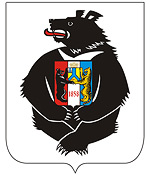
Khabarovsk krai map, Russia
Khabarovsk krai latest news and posts from our blog:.
25 August, 2017 / Russian banknotes and the sights depicted on them .
1 August, 2017 / Khabarovsk - the view from above .
21 December, 2016 / Flying over diverse Russia .
21 April, 2013 / Khabarovsk - the center of the Russian Far East .
16 January, 2011 / Siberian tiger walking the highway .
More posts..
History of Khabarovsk Krai
In the Middle Ages, the territory of today’s Khabarovsk Krai was inhabited mainly by the peoples of the Tungus-Manchu language group, as well as Nivkhs. In China they were known collectively as “wild Jurchen”. In the 13th-14th centuries, the Mongol rulers of China repeatedly organized expeditions to the lower Amur.
Russians began the development of the Far East in the 17th century. In 1639, a Cossack troop headed by Ivan Moskvitin reached the coast of the Sea of Okhotsk. The first stockade town was built in the mouth of the Ulya River. Later, Vasily Danilovich Poyarkov and Yerofei Pavlovich Khabarov were the first who started joining the Amur lands to Russia. Before Russians came here, the tribes of Daurs, Evenks, Natks, Gilyaks and others lived in this area (only about 30 thousand people).
The area was quickly populated by Russian settlers; new stockade towns were founded. But the process was interrupted due to a conflict with the Qing Dynasty. From the 1680s, Manchus started to fight against the Russian state.
More Historical Facts…
Russia could not move significant military forces to the Amur region and had to sign the Treaty of Nerchinsk (1689). According to it, Russians had to leave the left bank of the Amur River but managed to uphold its rights for the area behind Lake Baikal and the Sea of Okhotsk coast.
In the 18th century, Okhotsk became the main Pacific port of the Russian Empire. Development of the northern coast of the Pacific, exploration of the Kuril Islands and Sakhalin prepared the basis for the return of the Amur region.
In 1847, Nikolai Nikolayevich Muravyov was appointed a governor-general of Eastern Siberia. He did his best to return the Amur area to the Russian Empire. The number of Russians in the region began to grow. In 1858, the town of Khabarovsk was founded.
As a result of the weakening of China during the Opium Wars, two agreements were signed - the Aigun Treaty in 1858 and the Beijing Treaty in 1860. The Russian-Chinese border was established on the Amur and Ussuri rivers.
In 1884, Zabaikalskaya, Amurskaya and Primorskaya regions were united into Priamurskoye region with the center in Khabarovsk. Until the late 19th century, the Amur area was settled slowly. The situation changed in the early 20th century. In 1900, the Trans-Baikal Railway was opened, in 1902 - the Chinese Eastern Railway.
As a result, the number of settlers grew rapidly. In 1900-1913, about 300,000 peasants from other regions of the Russian Empire came to the Amur area. There were three towns (Khabarovsk, Nikolayevsk-on-Amur and Okhotsk) on the territory, which makes Khabarovsk krai today. By 1915, there were more than six thousand settlements with a total population of 316,300 people in Primorskaya oblast.
The Civil War lead to a great number of deaths and economic collapse in Russia. The restoration of pre-war level of economy was achieved by 1926. New cities were built in the region - Komsomolsk-on-Amur, Birobidzhan. October 20, 1938, Dalnevostochny region was divided into Khabarovsky and Primorsky regions.
In 1947-1948, Sakhalin and Amur regions were separated from Dalnevostochny region. In 1953, Magadan region was formed and separated from Dalnevostochny region. In 1956, Kamchatka region became independent too. In 1991, the Jewish autonomous region was separated from Dalnevostochny region.
Nature of Khabarovsk Krai
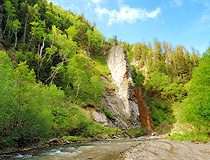
Khabarovsk Krai scenery
Author: Alexander Semyonov
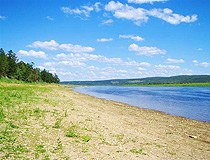
Khabarovsk Krai landscape
Author: Alexander Makharov
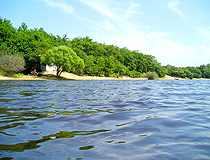
Lake in Khabarovsk Krai
Author: Ezerskiy Feliks
Khabarovsk Krai - Features
Khabarovsk Krai is one of the largest administrative-territorial units of the Russian Federation. The territory of the region stretches for about 1,800 kilometers from north to south, and for 125-750 km from west to east. The distance from Khabarovsk to Moscow is 8,533 km by rail, 8,385 by roads and 6,075 km by air.
Part of the southern boundary of the Khabarovsk region is the state border of Russia with China. The province is washed by the Sea of Okhotsk and the Sea of Japan. The coastline extension is 3,390 km, including islands, the largest of them are Shantarsky Islands. The highest point is Berill Mountain (2,933 meters).
The climate of the region changes from north to south. Winters are long and snowy. The average temperature in January is in the range of minus 22-40 degrees Celsius, on the coast - minus 18-24 degrees Celsius. Summers are hot and humid. The average temperature in July is about plus 15-20 degrees Celsius.
In general, Khabarovsk Krai is one of the most sparsely populated regions of Russia, which is due, firstly, the general economic decline of the post-Soviet time, and secondly - the severity of the local climate, comparable with the regions of the Far North.
The largest cities and towns are Khabarovsk (613,500), Komsomolsk-on-Amur (239,400) Amursk (38,200), Sovetskaya Gavan (22,900), Nikolaevsk-on-Amur (17,400), Bikin (15,900).
Khabarovsk Krai - Economy and Transport
The main branches of the local economy are mechanical engineering and metalworking, ferrous metallurgy, mining, fishing, food, light and timber industries. The mineral resources of the region include gold, tin, aluminum, iron, coal and lignite, graphite.
The main highways of Khabarovsk Krai are M60 “Ussuri” (Khabarovsk - Ussuriysk - Vladivostok) and M58 “Amur” (Chita - Never - Svobodny - Arkhara - Birobidzhan - Khabarovsk). The railway station “Khabarovsk-2” is a large railway hub. The directions are as follows: to the south (to Vladivostok and Port Vostochny), to the west (to Moscow) and to the north (to Komsomolsk-on-Amur).
The river port in Khabarovsk is the largest on the Amur River. The other river ports of the region are located in Komsomolsk and Nikolayevsk. The sea ports of the region are Okhotsk, Ayan, Nikolayevsk-on-Amur, Vanino, Sovetskaya Gavan.
Tourism in Khabarovsk Krai
The rich natural potential of the region provides endless opportunities for the development of ecological tourism. You can see reindeer, brown and Himalayan bears, bighorn sheep and even the Siberian tigers on the territory of Khabarovsk krai.
The Amur River is the main attraction of the region. Most of natural, cultural and historical tourist sites are concentrated in the valley of this river.
Shantarsky Islands, one of the most beautiful and unique places of unspoiled nature, are another natural attraction of this region. The inaccessibility of the islands allowed to preserve pristine nature. Shantarsky Islands are a habitat of whales, seals, killer whales. It is a great place for fishing.
If you prefer ethnographic tourism, you may be interested in cave paintings located near the Nanai village of Sikachi-Alyan and Lake Bolon, which is a large bird sanctuary. In the past, there were a Buddhist temple and ancient settlements in the vicinity of the lake.
Lovers of adventure tourism may be interested in rafting, fishing tours, caving and winter recreation.
The best time for tourism in Khabarovsk krai: “late spring - early summer”, “end of summer - early fall.”
The largest international airport in the region is located in Khabarovsk. The flights to Moscow, Vladivostok, Yuzhno-Sakhalinsk, Novosibirsk, Yakutsk, Krasnoyarsk, Irkutsk, Bangkok, Seoul, Harbin are available.
Khabarovsk krai of Russia photos
Pictures of khabarovsk krai.
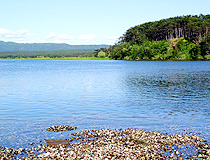
Author: Sergey Kotelnikov
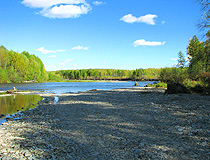
Author: Evgeniy Lopatin
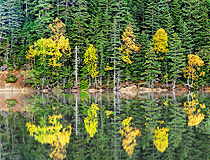
Forest in Khabarovsk Krai
Winter in Khabarovsk Krai
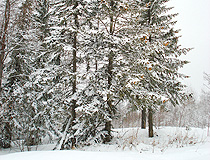
Author: Volman Michail
The questions of our visitors
The comments of our visitors.
- Currently 2.88/5
Rating: 2.9 /5 (161 votes cast)
Khabarovsk Krai
Administrative divisions, heavy industry, demographics, ethnic groups, settlements, sister relations, external links.
Being dominated by the Siberian High winter cold, the continental climates of the krai see extreme freezing for an area adjacent to the sea near the mid-latitudes, but also warm summers in the interior. The southern region lies mostly in the basin of the lower Amur River , with the mouth of the river located at Nikolaevsk-on-Amur draining into the Strait of Tartary , which separates Khabarovsk Krai from the island of Sakhalin . The north occupies a vast mountainous area along the coastline of the Sea of Okhotsk , a marginal sea of the Pacific Ocean . Khabarovsk Krai is bordered by Magadan Oblast to the north; Amur Oblast , Jewish Autonomous Oblast , and the Sakha Republic to the west; Primorsky Krai to the south; and Sakhalin Oblast to the east.
The population consists of mostly ethnic Russians , but indigenous people of the area are numerous, such as the Tungusic peoples ( Evenks , Negidals , Ulchs , Nanai , Oroch , Udege ), Amur Nivkhs , and Ainu . [10]
Khabarovsk Krai shares its borders with Magadan Oblast in the north; with the Sakha Republic and Amur Oblast in the west; with the Jewish Autonomous Oblast , China ( Heilongjiang ), and Primorsky Krai in the south; and is limited by the Sea of Okhotsk in the east. In terms of area, it is the fourth-largest federal subject within Russia. Major islands include the Shantar Islands .
Taiga and tundra in the north, swampy forest in the central depression, and deciduous forest in the south are the natural vegetation in the area. The main rivers are the Amur , Amgun , Uda , and Tugur , among others. There are also lakes such as Bokon , Bolon , Chukchagir , Evoron , Kizi , Khummi , Orel , and Udyl , among others. [11]
Khabarovsk Krai has a severely continental climate with its northern areas being subarctic with stronger maritime summer moderation in the north. In its southerly areas, especially inland, annual swings are extremely strong, with Khabarovsk itself having hot, wet, and humid summers which rapidly transform into severely cold and long winters, where temperatures hardly ever go above freezing. This is because of the influence of the East Asian monsoon in summer and the bitterly cold Siberian High in winter. The second-largest city of Komsomolsk-on-Amur has even more violent temperature swings than Khabarovsk, with winter average lows below −30 °C (−22 °F) , but in spite of this, avoiding being subarctic because of the significant heat in summer.
The main mountain ranges in the region are the Bureya Range , the Badzhal Range (highest point 2,221 metres (7,287 ft) high, the Gora Ulun ), the Yam-Alin , the Dusse-Alin , the Sikhote-Alin , the Dzhugdzhur Mountains , the Kondyor Massif , as well as a small section of the Suntar-Khayata Range , the Yudoma-Maya Highlands , and the Sette-Daban in the western border regions. The highest point is 2,933 metres (9,623 ft) high, Berill Mountain . [12] [13]
There are a number of peninsulas along the krai's extensive coast, the main ones being (north to south) the Lisyansky Peninsula , Nurki Peninsula , Tugurskiy Peninsula , and the Tokhareu Peninsula .
The main islands of Khabarovsk Krai (north to south) are Malminskiye Island , the Shantar Islands , Menshikov Island , Reyneke Island (Sea of Okhotsk) , Chkalov Island , Baydukov Island , and the Chastye Islands . The island of Sakhalin (Russia's largest) is administered separately as Sakhalin Oblast , along with the Kuril Islands .
The charts below detail climate averages from various locations in the krai. Khabarovsk is set near the Chinese border at a lower latitude far inland, while Komsomolsk-on-Amur being further downstream on the Amur river at a higher latitude. Sovetskaya Gavan and Okhotsk are coastal settlements in the deep south and far north, respectively.
According to various Chinese and Korean records, the southern part of Khabarovsk Krai was originally occupied by one of the five semi-nomadic Shiwei , the Bo Shiwei tribes, and the Black Water Mohe tribes living, respectively, on the west and the east of the Bureya and the Lesser Khingan ranges.
In 1643, Vassili Poyarkov 's boats descended the Amur , returning to Yakutsk by the Sea of Okhotsk and the Aldan River , and in 1649–1650, Yerofey Khabarov occupied the banks of the Amur. The resistance of the Chinese, however, obliged the Cossacks to quit their forts, and by the Treaty of Nerchinsk (1689), Russia abandoned its advance into the basin of the river.
Although the Russians were thus deprived of the right to navigate the Amur River, the territorial claim over the lower courses of the river was not settled in the Treaty of Nerchinsk of 1689. The area between the Uda River and the Greater Khingan mountain range (i.e. most of Lower Amuria) was left undemarcated and the Sino-Russian border was allowed to fluctuate. [20] [21]
Later in the nineteenth century, Nikolay Muravyov conducted an aggressive policy with China by claiming that the lower reaches of the Amur River belonged to Russia . In 1852, a Russian military expedition under Muravyov explored the Amur, and by 1857, a chain of Russian Cossacks and peasants had been settled along the whole course of the river. In 1858, in the Treaty of Aigun , China recognized the Amur River downstream as far as the Ussuri River as the boundary between Russia and the Qing Empire, and granted Russia free access to the Pacific Ocean. [22] The Sino-Russian border was later further delineated in the Treaty of Peking of 1860 when the Ussuri Territory (the Maritime Territory ), which was previously a joint possession, became Russian. [23]
Khabarovsk Krai was established on 20 October 1938, when the Far Eastern Krai was split into the Khabarovsk and Primorsky Krais . [24] Kamchatka Oblast , which was originally subordinated to the Far Eastern Krai, fell under the Jurisdiction of Khabarovsk Krai, along with its two National Okrugs, Chukotka and Koryak . In 1947, the northern part of Sakhalin was removed from the Krai to join the southern part and form Sakhalin Oblast . In 1948, parts of its southwestern territories were removed from the Krai to form Amur Oblast . In 1953, Magadan Oblast was established from the northern parts of the Krai and was given jurisdiction over Chukotka National Okrug, which was originally under the jurisdiction of Kamchatka oblast. In 1956, Kamchatka Oblast became its own region and took Koryak National Okrug with it. The Krai took its modern form in 1991, just before the USSR's collapse when the Jewish Autonomous Oblast was created within its territory. On 24 April 1996, Khabarovsk signed a power-sharing agreement with the federal government, granting it autonomy. [25] This agreement would be abolished on 12 August 2002. [26]

During the Soviet period, the high authority in the oblast was shared between three persons: The first secretary of the Khabarovsk CPSU Committee (who, in reality, had the biggest authority), the chairman of the oblast Soviet (legislative power), and the Chairman of the oblast Executive Committee (executive power). Since 1991, CPSU lost all the power, and the head of the Oblast administration, and eventually the governor, was appointed/elected alongside elected regional parliament .
The Charter of Khabarovsk Krai is the fundamental law of the krai. The Legislative Duma of Khabarovsk Krai is the regional standing legislative (representative) body. The Legislative Duma exercises its authority by passing laws, resolutions, and other legal acts and by supervising the implementation and observance of the laws and other legal acts passed by it. The highest executive body is the Krai Government, which includes territorial executive bodies, such as district administrations, committees, and commissions that facilitate development and run the day to day matters of the province. The Krai Administration supports the activities of the Governor , who is the highest official and acts as guarantor of the observance of the Charter in accordance with the Constitution of Russia .
On 9 July 2020, the governor of the region, Sergei Furgal , was arrested and flown to Moscow. The 2020 Khabarovsk Krai protests began on 11 July 2020, in support of Furgal. [27]

Khabarovsk Krai is the most industrialized territory of the Far East of Russia, producing 30% of the total industrial products in the Far Eastern Economic Region.
The machine construction industry consists primarily of a highly developed military–industrial complex of large-scale aircraft- and shipbuilding enterprises. [28] The Komsomolsk-on-Amur Aircraft Production Association is currently among the krai's most successful enterprises, and for years has been the largest taxpayer of the territory. [28] Other major industries include timber-working and fishing , along with metallurgy in the main cities. Komsomolsk-on-Amur is the iron and steel centre of the Far East; a pipeline from northern Sakhalin supplies the petroleum-refining industry in the city of Khabarovsk . In the Amur basin, there is also some cultivation of wheat and soybeans . The administrative centre , Khabarovsk, is at the junction of the Amur River and the Trans-Siberian Railway .
The region's mineral resources are relatively underdeveloped. Khabarovsk Krai contains large gold mining operations (Highland Gold, Polus Gold), a major but low-grade copper deposit being explored by IG Integro Group , and a world-class tin district which was a major contributor to the Soviet industrial complex and is currently being revitalised by Far Eastern Tin (Festivalnoye mine) and by Sable Tin Resources Archived March 13, 2017, at the Wayback Machine , which is developing the Sable Tin Deposit (Sobolinoye) , a large high-grade deposit, 25 km from Solnechny town.

Population : 1,292,944 ( 2021 Census ) ; [29] 1,343,869 ( 2010 Census ) ; [9] 1,436,570 ( 2002 Census ) ; [30] 1,824,506 ( 1989 Census ) . [31]
Vital statistics for 2022: [33] [34]
- Births: 12,404 (9.6 per 1,000)
- Deaths: 18,209 (14.0 per 1,000)
Total fertility rate (2022): [35] 1.50 children per woman
Life expectancy (2021): [36] Total — 67.85 years (male — 62.91, female — 72.94)
According to a 2012 survey, [37] 26.2% of the population of Khabarovsk Krai adheres to the Russian Orthodox Church , 4% are unaffiliated generic Christians , 1% adhere to other Orthodox churches or are believers in Orthodox Christianity who do not belong to any church, while 1% are adherents of Islam . In addition, 28% of the population declared to be "spiritual but not religious", 23% are atheist , and 16.8% follow other religions or did not give an answer to the question. [37]
There are the following institutions of higher education in Khabarovsk Krai. [39] [40]
- Pacific National University
- Far Eastern State University of Humanities
- Far Eastern State Medical University
- Khabarovsk State Academy of Economics and Law [ ru ]
- Far Eastern State Transport University
- Far Eastern Academy of Government Services
- Far Eastern State Physical Education University
- Khabarovsk State Institute of Arts and Culture
- Komsomolsk-on-Amur State Technical University
- Komsomolsk-on-Amur State Pedagogical institute
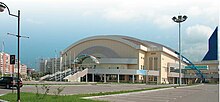
- Amur Khabarovsk , a professional hockey club of the international Kontinental Hockey League and plays its home games at the Platinum Arena .
- FC SKA-Energiya Khabarovsk is a professional association football team playing in the Russian Football National League , the second tier of Russian association football.
- SKA-Neftyanik is a professional bandy club which plays in the top-tier Russian Bandy Super League at its own indoor venue Arena Yerofey . In the 2016–17 season , the club became Russian champion for the first time. [41]
The city was a host to the 1981 Bandy World Championship as well as to the 2015 Bandy World Championship . For the 2015 games, twenty-one teams originally were expected, which would have been four more than the record-making seventeen from the 2014 tournament , but eventually, only sixteen teams came. The A Division of the 2018 Bandy World Championship was again to be played in Khabarovsk. [42]
- List of Chairmen of the Legislative Duma of Khabarovsk Krai
- Tourism in Khabarovsk Krai
Related Research Articles
Amur Oblast is a federal subject of Russia, located on the banks of the Amur and Zeya rivers in the Russian Far East. Amur Oblast borders Heilongjiang province of the People's Republic of China (PRC) to the south.

Okha is a town and the administrative center of Okhinsky District of Sakhalin Oblast, Russia. Population: 23,008 (2010 Census) ; 27,963 (2002 Census) ; 36,104 (1989 Census) .
Sakhalin Oblast is a federal subject of Russia comprising the island of Sakhalin and the Kuril Islands in the Russian Far East. The oblast has an area of 87,100 square kilometers (33,600 sq mi). Its administrative center and largest city is Yuzhno-Sakhalinsk. As of the 2021 Census, the oblast has a population of roughly 500,000.

Komsomolsk-on-Amur is a city in Khabarovsk Krai, Russia, located on the west bank of the Amur River in the Russian Far East. It is located on the Baikal-Amur Mainline, 356 kilometers (221 mi) northeast of Khabarovsk. Population: 238,505 (2021 Census) ; 263,906 (2010 Census) ; 281,035 (2002 Census) ; 315,325 (1989 Census) .

Nikolayevsk-on-Amur is a town in Khabarovsk Krai, Russia located on the Amur River close to its liman in the Pacific Ocean. Population: 22,752 (2010 Census) ; 28,492 (2002 Census) ; 36,296 (1989 Census) .

Sovetskaya Gavan is a town in Khabarovsk Krai, Russia, and a port on the Strait of Tartary which connects the Sea of Okhotsk in the north with the Sea of Japan in the south. Population: 27,712 (2010 Census) ; 30,480 (2002 Census) ; 34,915 (1989 Census) .
Kamchatka Krai is a federal subject of Russia, situated in the Russian Far East. It is administratively part of the Far Eastern Federal District. Its administrative center and largest city is Petropavlovsk-Kamchatsky, home to over half of its population of 291,705.

Amursk is a town in Khabarovsk Krai, Russia, located on the left bank of the Amur River 45 kilometers (28 mi) south of Komsomolsk-on-Amur. Population: 42,970 (2010 Census) ; 47,759 (2002 Census) ; 58,395 (1989 Census) .

Lesozavodsk is a town in Primorsky Krai, Russia, located on the Ussuri River, 10 kilometers (6.2 mi) from the Sino–Russian border and about 300 kilometers (190 mi) north of Vladivostok, the administrative center of the krai. Population: 37,034 (2010 Census) ; 42,185 (2002 Census) ; 44,065 (1989 Census) ; 37,000 (1972).
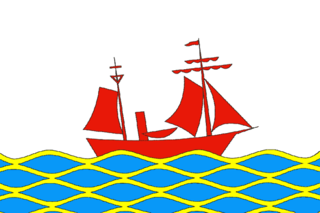
Poronaysk is a town and the administrative center of Poronaysky District of Sakhalin Oblast, Russia, located on the Poronay River 288 kilometers (179 mi) north of Yuzhno-Sakhalinsk. Population: 16,120 (2010 Census) ; 17,954 (2002 Census) ; 25,971 (1989 Census) .

Ayano-Maysky District is an administrative and municipal district (raion), one of the seventeen in Khabarovsk Krai, Russia. It is located in the north of the krai. The area of the district is 167,200 square kilometers (64,600 sq mi). Its administrative center is the rural locality of Ayan. Population: 2,292 (2010 Census) ; 3,271 (2002 Census) ; 4,802 (1989 Census) . The population of Ayan accounts for 42.2% of the district's total population.

Fevralsk is an urban locality in Selemdzhinsky District of Amur Oblast, Russia, located between the Selemdzha River and its tributary the Byssa, about 340 kilometers (210 mi) northeast of Blagoveshchensk, the oblast's administrative center, and 204 kilometers (127 mi) southwest of Ekimchan, the administrative center of the district. Population: 5,128 (2010 Census) ; 4,690 (2002 Census) ; 8,816 (1989 Census) .

Novy Urgal is an urban locality in Verkhnebureinsky District of Khabarovsk Krai, Russia, located in the valley of the Bureya River, close to its confluence with the Urgal River, about 340 kilometers (210 mi) northwest of the krai's administrative center of Khabarovsk and 28 kilometers (17 mi) west of the district's administrative center of Chegdomyn. Population: 6,803 (2010 Census) ; 7,274 (2002 Census) ; 9,126 (1989 Census) .

Nogliki is an urban locality and the administrative center of Nogliksky District of Sakhalin Oblast, Russia, located near the eastern coast of Sakhalin Island, about 6 kilometers (3.7 mi) inland from the Sea of Okhotsk shoreline and about 600 kilometers (370 mi) north of Yuzhno-Sakhalinsk. Population: 10,231 (2010 Census) ; 10,729 (2002 Census) ; 11,546 (1989 Census) .

Komsomolsky District is an administrative and municipal district (raion), one of the seventeen in Khabarovsk Krai, Russia. It is located in the southern central part of the krai. The area of the district is 25,167 square kilometers (9,717 sq mi). Its administrative center is the city of Komsomolsk-on-Amur. Population: 29,072 (2010 Census) ; 31,563 (2002 Census) ; 33,649 (1989 Census) .

Nikolayevsky District is an administrative and municipal district (raion), one of the seventeen in Khabarovsk Krai, Russia. It is located in the east of the krai. The area of the district is 17,188 square kilometers (6,636 sq mi). Its administrative center is the town of Nikolayevsk-on-Amur. Population: 9,942 (2010 Census) ; 13,850 (2002 Census) ; 19,683 (1989 Census) .

Okhotsky District is an administrative and municipal district (raion), one of the seventeen in Khabarovsk Krai, Russia. It is located in the north of the krai. The area of the district is 158,517.8 square kilometers (61,204.1 sq mi). Its administrative center is the urban locality of Okhotsk. Population: 8,197 (2010 Census) ; 12,017 (2002 Census) ; 19,183 (1989 Census) . The population of Okhotsk accounts for 51.4% of the district's total population.

Tuguro-Chumikansky District is an administrative and municipal district (raion), one of the seventeen in Khabarovsk Krai, Russia. It is located in the center of the krai. The area of the district is 96,069 square kilometers (37,092 sq mi). Its administrative center is the rural locality of Chumikan. Population: 2,255 (2010 Census) ; 2,860 (2002 Census) ; 3,610 (1989 Census) . The population of Chumikan accounts for 47.0% of the district's total population.

Smidovichsky District is an administrative and municipal district (raion), one of the five in the Jewish Autonomous Oblast, Russia. It is located in the east of the autonomous oblast and borders Khabarovsk Krai in the north and east, China in the south, and Birobidzhansky District in the west. The area of the district is 5,900 square kilometers (2,300 sq mi). Its administrative center is the urban locality of Smidovich. As of the 2010 Census, the total population of the district was 28,165, with the population of Smidovich accounting for 18.2% of that number.
Selikhino is a rural locality in Komsomolsky District of Khabarovsk Krai, Russia. Population: 4,255 (2010 Census) ; 4,865 (2002 Census) .
- ↑ Президент Российской Федерации. Указ №849 от 13 мая 2000 г. «О полномочном представителе Президента Российской Федерации в федеральном округе». Вступил в силу 13 мая 2000 г. Опубликован: "Собрание законодательства РФ", No. 20, ст. 2112, 15 мая 2000 г. (President of the Russian Federation. Decree # 849 of May 13, 2000 On the Plenipotentiary Representative of the President of the Russian Federation in a Federal District . Effective as of May 13, 2000.).
- ↑ Госстандарт Российской Федерации. №ОК 024-95 27 декабря 1995 г. «Общероссийский классификатор экономических регионов. 2. Экономические районы», в ред. Изменения №5/2001 ОКЭР. ( Gosstandart of the Russian Federation. # OK 024-95 December 27, 1995 Russian Classification of Economic Regions. 2. Economic Regions , as amended by the Amendment # 5/2001 OKER. ).
- 1 2 Charter of Khabarovsk Krai, Article 4
- ↑ "Оценка численности постоянного населения по субъектам Российской Федерации" . Federal State Statistics Service . Retrieved September 1, 2022 .
- ↑ "26. Численность постоянного населения Российской Федерации по муниципальным образованиям на 1 января 2018 года" . Federal State Statistics Service . Retrieved January 23, 2019 .
- ↑ "Об исчислении времени" . Официальный интернет-портал правовой информации (in Russian). June 3, 2011 . Retrieved January 19, 2019 .
- ↑ Official throughout the Russian Federation according to Article 68.1 of the Constitution of Russia .
- 1 2 Russian Federal State Statistics Service (2011). Всероссийская перепись населения 2010 года. Том 1 [ 2010 All-Russian Population Census, vol. 1 ] . Всероссийская перепись населения 2010 года [2010 All-Russia Population Census] (in Russian). Federal State Statistics Service .
- ↑ Chaussonnet, p.109
- ↑ Topographic map N-53; M 1: 1,000,00
- ↑ Khabarovsk Krai Mountains - PeakVisor
- ↑ Google Earth
- ↑ "Pogoda.ru.net" (in Russian) . Retrieved November 8, 2021 .
- ↑ "Habarovsk/Novy (Khabarovsk) Climate Normals 1961–1990" . National Oceanic and Atmospheric Administration . Retrieved November 2, 2021 .
- ↑ "climatebase.ru (1948-2011)" . Retrieved April 28, 2012 .
- ↑ "Weatherbase: Historical Weather for Komsomolsk-on-Amur, Russia" . Weatherbase. 2012. Retrieved on November 24, 2011.
- ↑ "Weather and Climate-The Climate of Okhotsk" (in Russian). Weather and Climate (Погода и климат). Archived from the original on December 3, 2019 . Retrieved December 3, 2019 .
- ↑ "Ohotsk (Okhotsk) Climate Normals 1961–1990" . National Oceanic and Atmospheric Administration . Retrieved December 3, 2019 .
- ↑ "1689, Nerchinsk – Russia" . China's External Relations .
- ↑ Alexei D. Voskressenski (2002). Russia and China: A Theory of Inter-State Relations . Routledge. pp. 107–108. ISBN 978-0700714957 .
- ↑ "1858, Aigun – Russia" . China's External Relations .
- ↑ Alexei D. Voskressenski (2002). Russia and China: A Theory of Inter-State Relations . Routledge. pp. 112–113. ISBN 978-0700714957 .
- ↑ Decree of October 20, 1938
- ↑ Solnick, Steven (May 29, 1996). "Asymmetries in Russian Federation Bargaining" (PDF) . The National Council for Soviet and East European Research : 12. Archived (PDF) from the original on October 9, 2022.
- ↑ Chuman, Mizuki. "The Rise and Fall of Power-Sharing Treaties Between Center and Regions in Post-Soviet Russia" (PDF) . Demokratizatsiya : 146. Archived (PDF) from the original on October 9, 2022.
- ↑ "Anger at Kremlin Grows in Latest Massive Russian Far East Protest" . The Moscow Times . July 25, 2020.
- 1 2 "KNAAPO Komsomolsk na Amure Aviation Industrial Association named after Gagarin - Russian" . www.globalsecurity.org .
- ↑ Russian Federal State Statistics Service. Всероссийская перепись населения 2020 года. Том 1 [ 2020 All-Russian Population Census, vol. 1 ] (XLS) (in Russian). Federal State Statistics Service .
- ↑ Russian Federal State Statistics Service (May 21, 2004). Численность населения России, субъектов Российской Федерации в составе федеральных округов, районов, городских поселений, сельских населённых пунктов – районных центров и сельских населённых пунктов с населением 3 тысячи и более человек [ Population of Russia, Its Federal Districts, Federal Subjects, Districts, Urban Localities, Rural Localities—Administrative Centers, and Rural Localities with Population of Over 3,000 ] (XLS) . Всероссийская перепись населения 2002 года [All-Russia Population Census of 2002] (in Russian).
- ↑ Всесоюзная перепись населения 1989 г. Численность наличного населения союзных и автономных республик, автономных областей и округов, краёв, областей, районов, городских поселений и сёл-райцентров [ All Union Population Census of 1989: Present Population of Union and Autonomous Republics, Autonomous Oblasts and Okrugs, Krais, Oblasts, Districts, Urban Settlements, and Villages Serving as District Administrative Centers ] . Всесоюзная перепись населения 1989 года [All-Union Population Census of 1989] (in Russian). Институт демографии Национального исследовательского университета: Высшая школа экономики [Institute of Demography at the National Research University: Higher School of Economics]. 1989 – via Demoscope Weekly .
- ↑ "Национальный состав населения" . Federal State Statistics Service . Retrieved December 30, 2022 .
- ↑ "Information on the number of registered births, deaths, marriages and divorces for January to December 2022" . ROSSTAT . Archived from the original on March 2, 2023 . Retrieved February 21, 2023 .
- ↑ "Birth rate, mortality rate, natural increase, marriage rate, divorce rate for January to December 2022" . ROSSTAT . Archived from the original on March 2, 2023 . Retrieved February 21, 2023 .
- ↑ Суммарный коэффициент рождаемости [ Total fertility rate ] . Russian Federal State Statistics Service (in Russian). Archived from the original (XLSX) on August 10, 2023 . Retrieved August 10, 2023 .
- ↑ "Демографический ежегодник России" [ The Demographic Yearbook of Russia ] (in Russian). Federal State Statistics Service of Russia (Rosstat) . Retrieved June 1, 2022 .
- 1 2 3 "Arena: Atlas of Religions and Nationalities in Russia" . Sreda, 2012.
- ↑ 2012 Arena Atlas Religion Maps . "Ogonek", № 34 (5243), 27/08/2012. Retrieved 21/04/2017. Archived .
- ↑ The Institutions of Higher Education in Khabarovsk Krai Archived December 28, 2005, at the Wayback Machine
- ↑ "Independent Russian and Ukrainian Interpreters" . RusMoose.com .
- ↑ "Google Translate" . translate.google.co.uk .
- ↑ "Annual Congress in Sandviken, Sweden on Jan 30 2017 2017-01-28" (PDF) . Archived from the original (PDF) on December 4, 2017 . Retrieved February 23, 2017 .
- ↑ Gyeongsangnam-do official website English Archived September 21, 2008, at the Wayback Machine
- ↑ "Sister cities of the Hyogo Prefecture" . Archived from the original on October 29, 2007 . Retrieved January 10, 2009 .
- Хабаровская краевая Дума. Постановление №150 от 30 ноября 1995 г. «Устав Хабаровского края», в ред. Закона №152 от 23 декабря 2015 г. «О внесении изменений в статьи 26 и 34 Устава Хабаровского края». Вступил в силу 16 января 1996 г. Опубликован: "Тихоокеанская звезда", №№7–8, 13 и 16 января 1996 г. (Khabarovsk Krai Duma. Resolution # 150 of November 30, 1995 Charter of Khabarovsk Krai , as amended by the Law # 152 of December 23, 2015 On Amending Articles 26 and 34 of the Charter of Khabarovsk Krai . Effective as of January 16, 1996.).
- Президиум Верховного Совета СССР. Указ от 20 октября 1938 г. «О разделении Дальневосточного края на Приморский и Хабаровский края». ( Presidium of the Supreme Soviet of the USSR . Decree of October 20, 1938 On Splitting Far Eastern Krai into Primorsky and Khabarovsk Krais . ).
- Chaussonnet, Valerie (1995) Native Cultures of Alaska and Siberia . Arctic Studies Center. Washington, D.C. 112p. ISBN 1-56098-661-1
- (in Russian) — Official website of Khabarovsk Krai
- Information concerning the Shiwei tribes and their relationship with the Khitans
- (in Russian) — Brief history of Khabaovsk Krai

COMMENTS
The Trek Size Finder. This online tool helps determine the bike size that's best for you. You'll need a measuring device for your height and inseam. If you find you're between sizes, we recommend contacting your retailer or calling us at 800-585-8735 (M-F) for a quick consult. Find your size.
These Trek road bike size charts shall help you pick the right bicycle that can go a long way for an adventurous ride. Category - Performance/Gravel. Models/Series - Madone, Emonda, and Domane. HEIGHT. INSEAM. SIZE. 5'0″-5'2″ (152-158cm) 28″-30″ (71-75cm) 47.
Calculate the bike size: 83.8 cm × 0.225 = 18.8 ≐ 19 inches. The size of your new mountain bike should be 19 inches. Example of Calculating the Road Bike Size: Your inseam length is 70 cm, and you want to buy a new road bike: 70 cm × 0.665 = 46.55 cm ≐ 47 cm. As you can see, your new road bike size should be 47 cm.
Road Bike Size Chart for Men. Height. Inside leg. Male's bike size. 47 cm to 152 cm/4'10 inch to 5'0 inch. 66 cm/26 inch. 47, 48 centimeters (XX S) 152 cm to 160 cm/5'0 inch to 5'3 inch. 69 cm/27 inch.
The Trek road bike range is based around three anagrammatic models; Domane, Madone, and Emonda - nominally the endurance, aero, and climbing bikes respectively. ... Sizes: 47-62. E-bike version ...
Because of this, it is one of the two key figures to determine how one bike compares to another. For example, a Trek Emonda has a reach of 386mm in a size 54cm frame, a Specialized Tarmac SL7 has ...
Road bike sizing: what size bike do I need? - BikeRadar
Learn how to choose the right bike size for your height, riding style and preferences. Compare road, MTB and hybrid bike sizes with our handy guide.
Trek Road Bike Sizing. Trek road bicycles are being made in four different categories, depending on the riders needs. Aero road bikes have excellent aerodynamics and they are the choice for riders who are looking for speed and performance.Lightweight road bikes are excellent climbers and all-around bicycles.Endurance road bikes are built for those riders who spend a lot of time in the saddle ...
Road bikes will often use measurements in centimeters to denote frame sizes. If you're looking at a road bike and you don't know what size it is, start by measuring the seat tube, as that will give you a good ballpark idea. Size. Height. Inseam. 47. 152.0 - 158.0 cm. 4'11.8" - 5'2.2". 71.0 - 75.0 cm.
Use the Trek Bikes Size Chart to find the right size and fit each time for bikes from Trek Bikes. SCHEELS
Finding the correct frame size is key to your safety and enjoyment. Our guide walks you through everything you need to know in order to measure a bike frame.
The recommended frame size for a height range of 5'4″ - 5'10" is 17. 5 inches, and for those with a height range of 5'8″ - 6'2″, the suggested frame size is 20 inches. By following this guide, you can ensure that you choose the right size Trek hybrid bike for your height. Credit: www.leisurelakesbikes.com.
Trek bike sizing is very straightforward and varies by type. For example, mountain bikes follow a unique method called alpha sizing that uses designations such as small, medium, or large. Using this system, a 5'3" to 5'7" tall person can use a 17.5" frame size. On the other hand, Trek road bike sizing takes into account the inseam length.
Full Specification. Frame: 7th-generation Trek Madone SLR, size 60 Colour: Red Groupset: New SRAM Red AXS Brakes: SRAM Red Disc, 160 front/140 rear rotors Cranks: SRAM Red 175 w/ Quarq Power Meter Chainrings: SRAM Red 54/41 Cassette: SRAM Red 10-33 Chain: SRAM Red Flattop Wheels: RSL62 Tubeless Pedals: TIME XPRO 10 Tires: Pirelli PZERO Race TLR RS, 28mm Cockpit: Madone RSL 120mm (-7 degree ...
Khabarovsk Krai - Features. Khabarovsk Krai is one of the largest administrative-territorial units of the Russian Federation. The territory of the region stretches for about 1,800 kilometers from north to south, and for 125-750 km from west to east. The distance from Khabarovsk to Moscow is 8,533 km by rail, 8,385 by roads and 6,075 km by air.
You're looking at the United Kingdom / English Trek Bicycle website. Don't worry. We've all taken a wrong turn before. View your country/region ... Fit & Sizing; We're here to help you with your bike sizing and cycle clothing sizing needs. Sizing charts. Use the "sizing & fit" link at the top of any product page to find the size that's ...
Khabarovsk Krai (Russian: Хабаровский край, romanized: Khabarovskiy kray, IPA: [xɐˈbarəfskʲɪj kraj]) is a federal subject (a krai) of Russia.It is located in the Russian Far East and is administratively part of the Far Eastern Federal District.The administrative centre of the krai is the city of Khabarovsk, which is home to roughly half of the krai's population and the ...
View your country/region's Trek Bicycle website here. Fit & Sizing. Trek Bike Size Finder Apparel fit guidelines Fit & Sizing; We're here to help you with your bike sizing and cycling apparel sizing needs. ... If you fall across two sizes or have questions about the bikes size that will best suit you, see the expert fit technicians at your ...
DOI: 10.1134/s1075701523080019 Corpus ID: 267586213; The Ore Mineral Composition of Gold-Bearing Metasomatites of the Kutyn Deposit, Khabarovsk Krai @article{Azaryan2023TheOM, title={The Ore Mineral Composition of Gold-Bearing Metasomatites of the Kutyn Deposit, Khabarovsk Krai}, author={A. M. Azaryan and Elena Badanina and I. S. Anisimov}, journal={Geology of Ore Deposits}, year={2023}, url ...
Lesozavodsk is a town in Primorsky Krai, Russia, located on the Ussuri River, 10 kilometers (6.2 mi) from the Sino-Russian border and about 300 kilometers (190 mi) north of Vladivostok, the administrative center of the krai. Population: 37,034 (2010 Census); 42,185 (2002 Census); 44,065 (1989 Census); 37,000 (1972).
Electrify your everyday on a used Trek electric bike. All Red Barn Refresh used e-bikes have been revitalized to ride like new. Shop used e-bikes today!